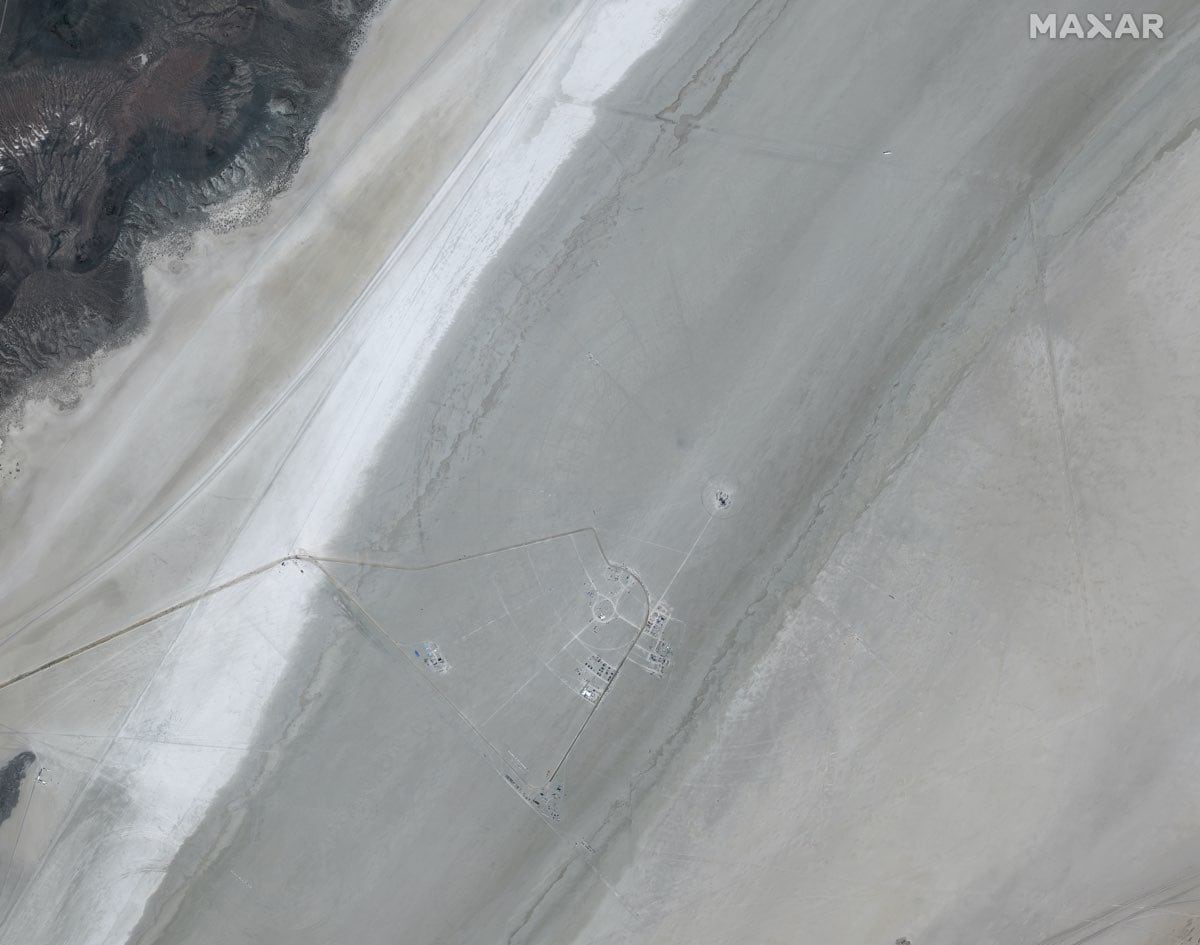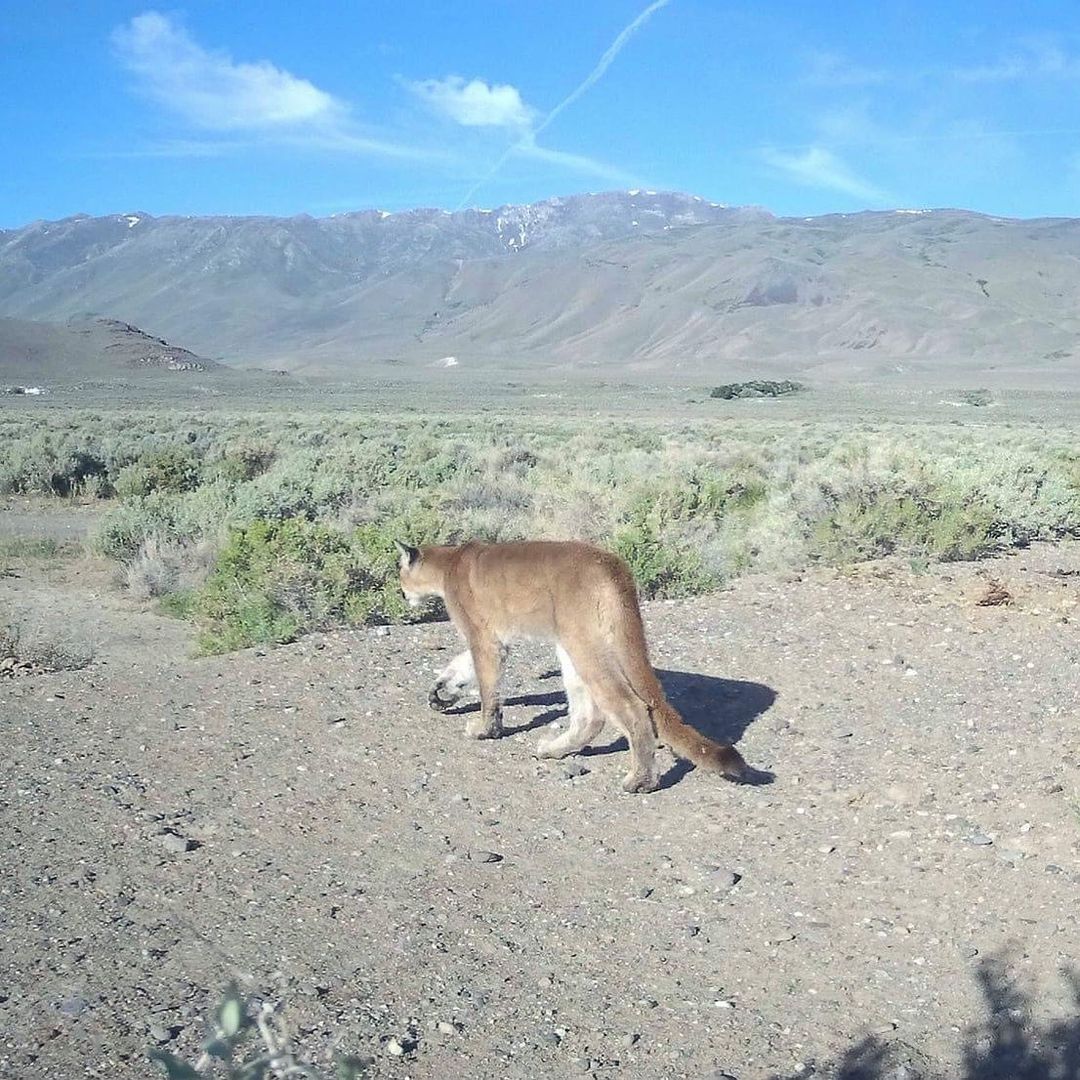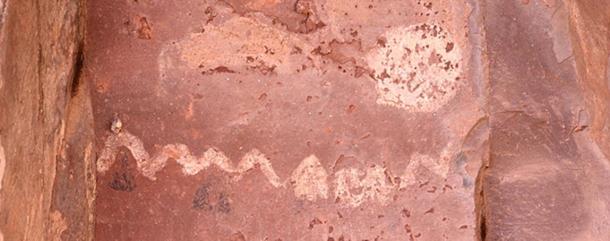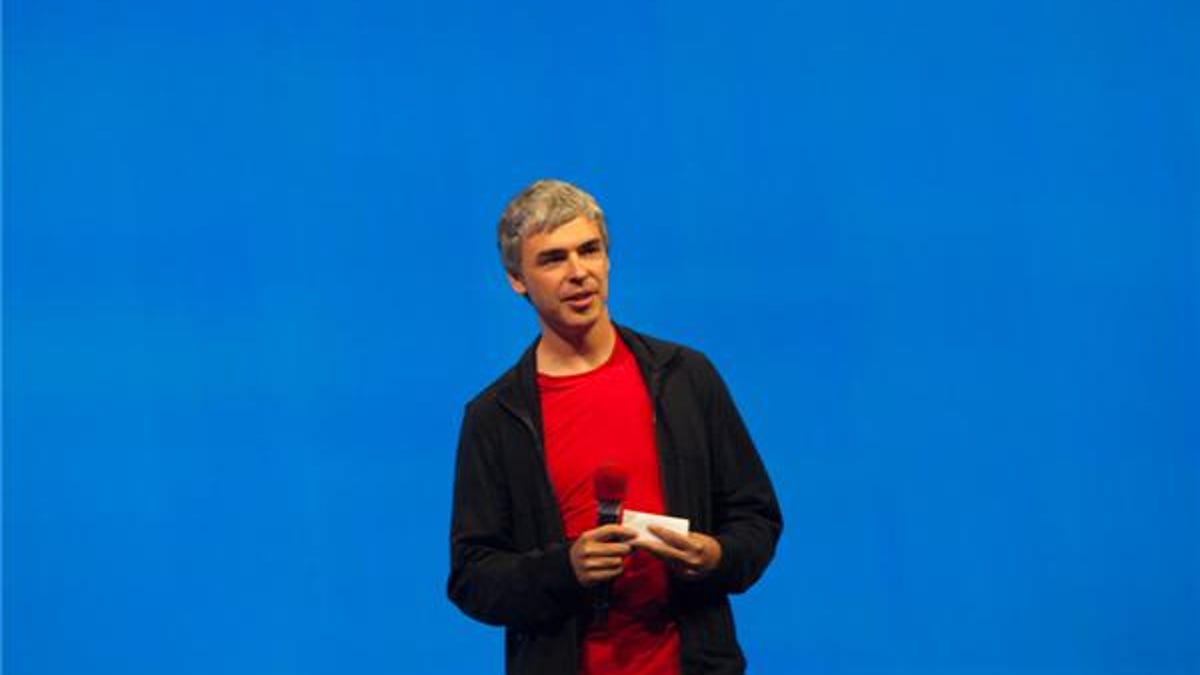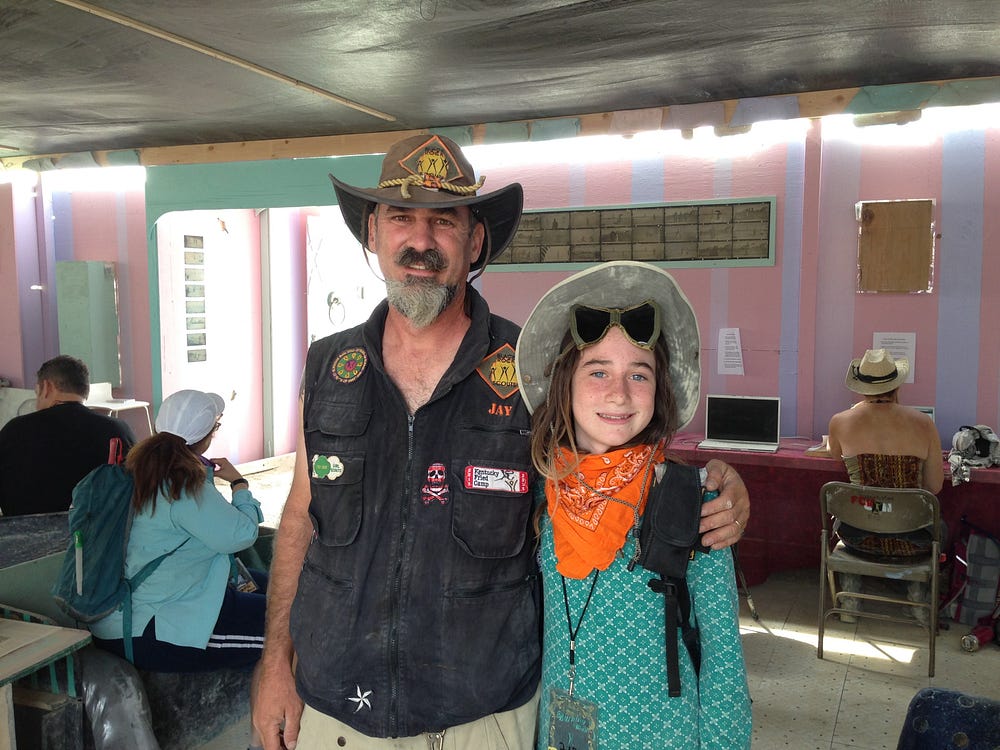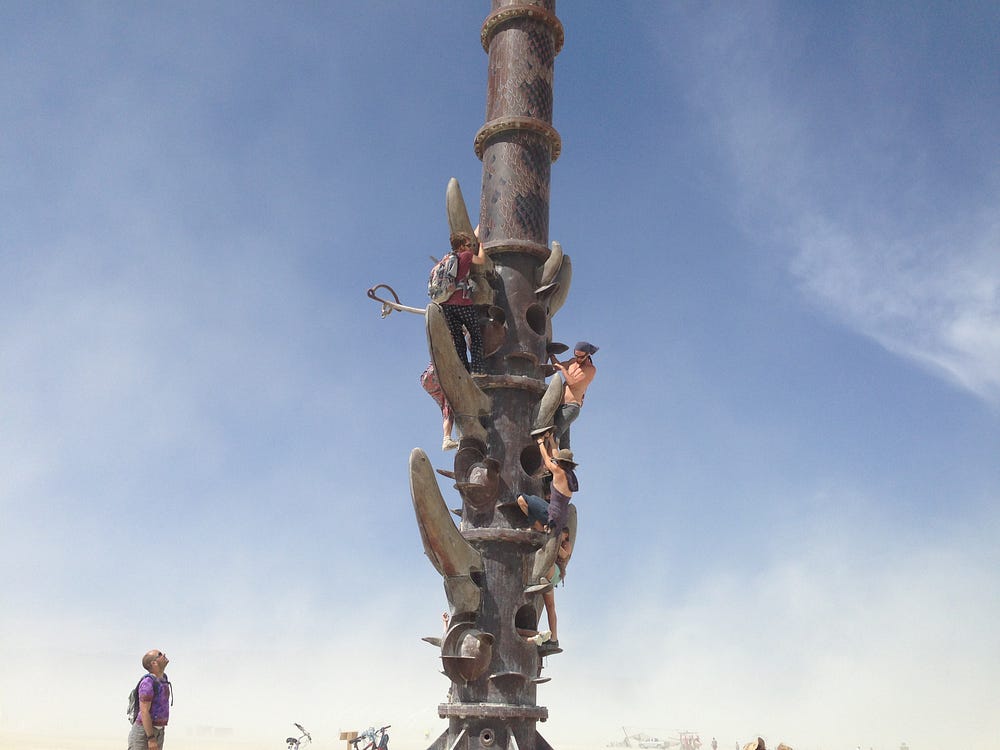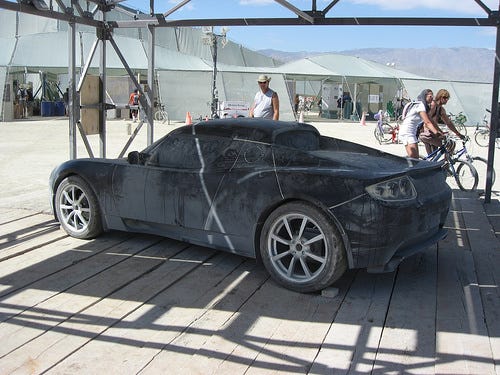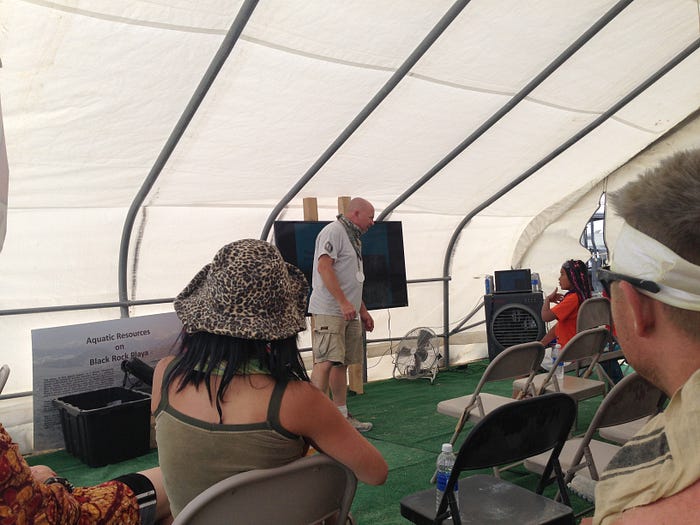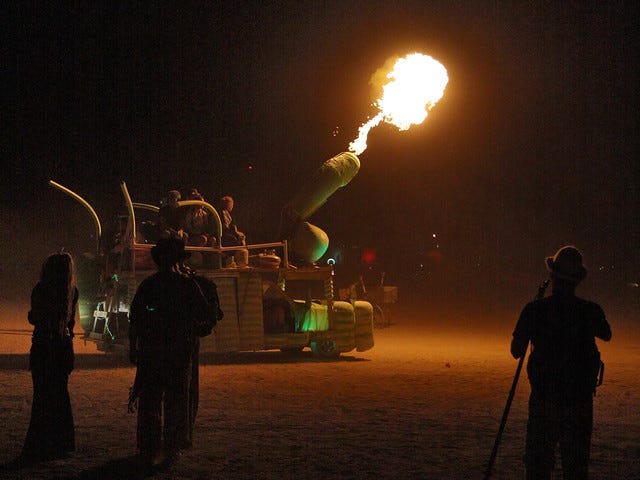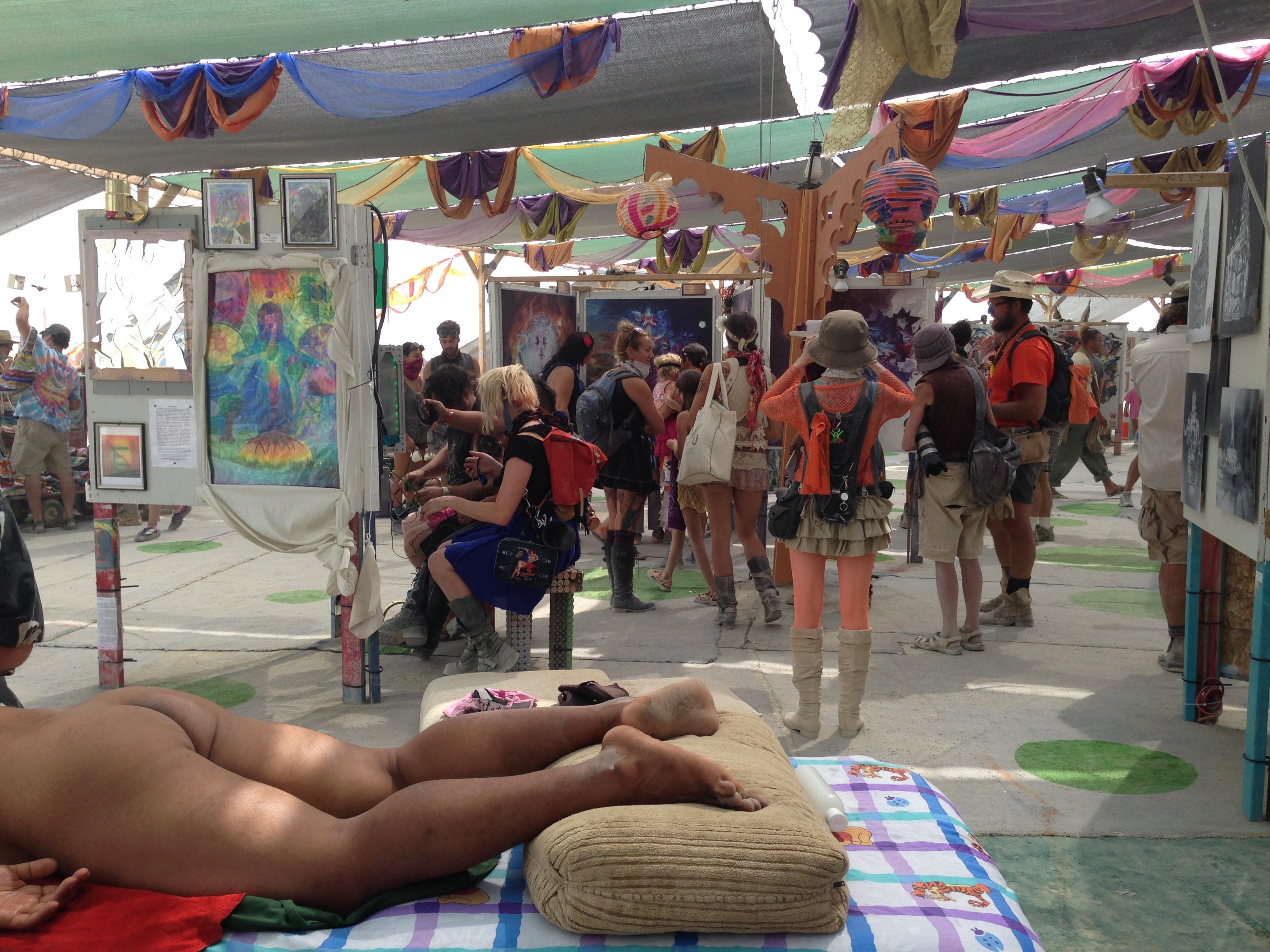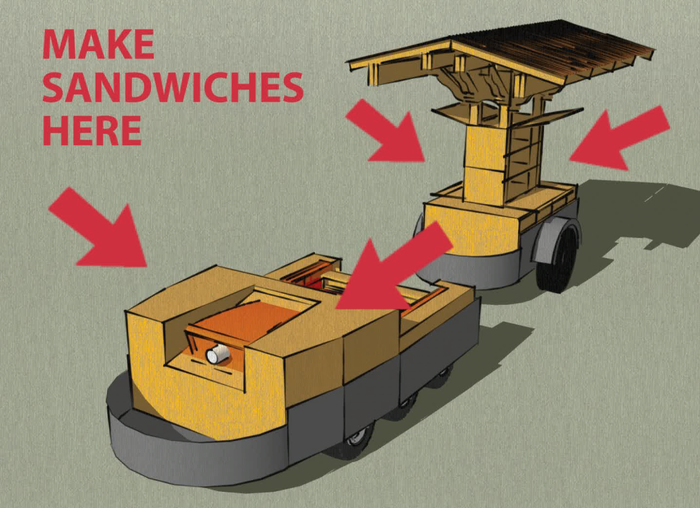
 |
 |

| On this webpage you will find an interactive photo of the snake where you can get an idea of the size and length and structure.
You will also find a tic toc video of the snake at night and the flames and lights involved in its display. The entire snake is lit through the night with flames coming from every “bone” in its very long spine. A flame rises high from the egg, falls and is extinguished; ONLY to rise again to view the interactive photo and the tictoc video. |
 |
Dust, costumes, weirdness — and science: Burning Man is back
Jennifer A. Kingson, author of Axios What’s Next
Aug 26, 2022
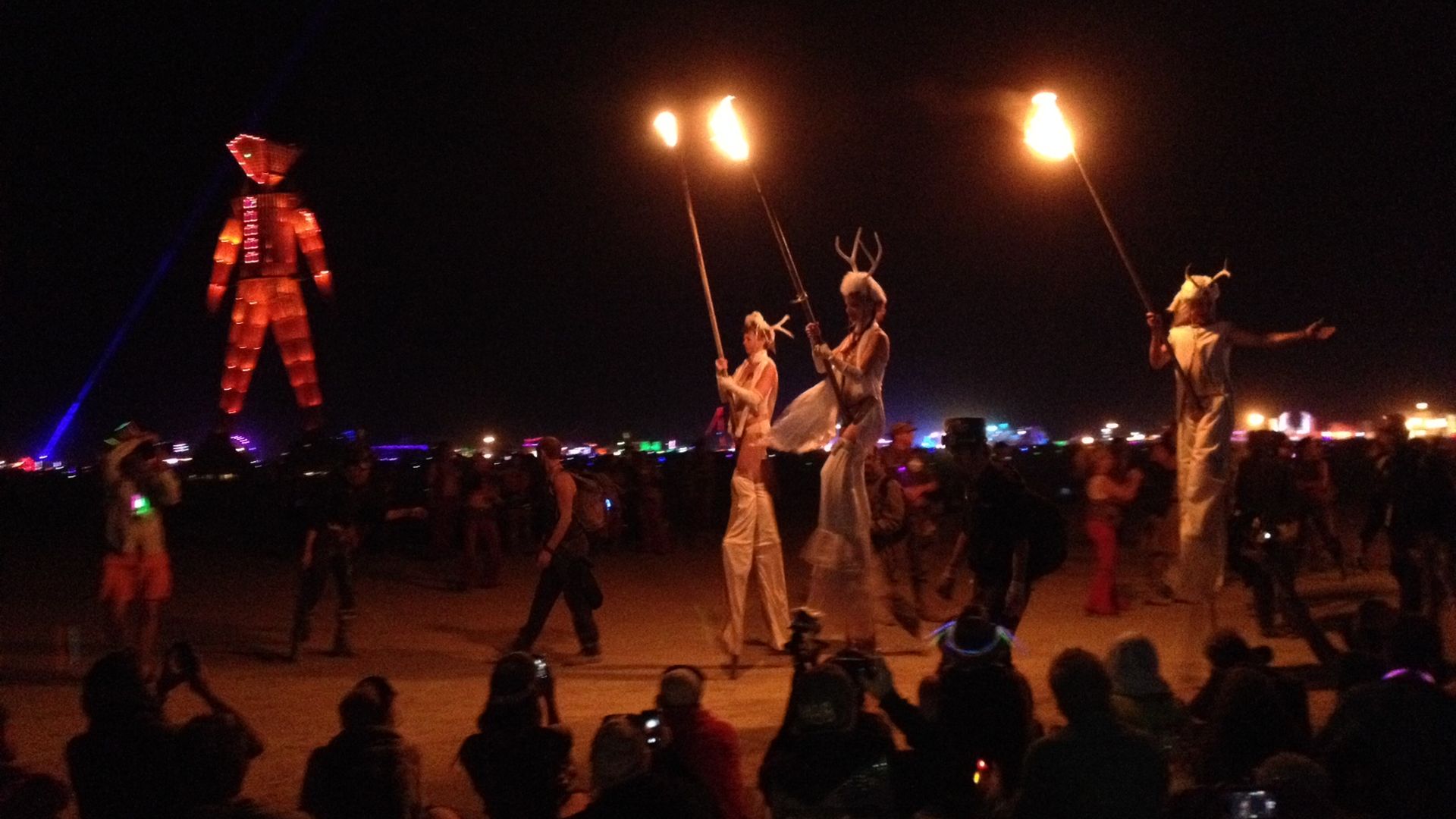
The annual Burning Man bacchanal in the Nevada desert returns Sunday after a two-year COVID-19 hiatus— this time with a team of Massachusetts Institute of Technology researchers conducting a science experiment with implications for online social networks.
Etymology, origin and meaning of bacchanal by etymonline“drunken revelry,” 1630s, from the name of the Roman festival held in honor of Bacchus, from neuter plural of Latin bacchanalis “having to do with Bacchus” (q.v.); the festivals became so notorious for excess that they were forbidden by the Senate 186 B.C.E. A participant is a Ba. |
Bacchanal Definition & MeaningDictionary.com
an occasion of drunken revelry; orgy; bacchanalia.
|
spacer
Why it matters: The arrival of about 80,000 whimsically costumed revelers at a makeshift encampment called Black Rock City marks some sort of reassuring-yet-ironic return to normalcy.
- And the addition of a hard science project with real-world relevance highlights the event’s role as a meaningful cultural phenomenon.
Driving the news: As the “Burners” arrive in Black Rock City (near Reno), MIT Media Lab researchers will hand out 600 small vessels that look like Altoids tins.
- Their goal is for people to pass them around and use the pen and paper inside to notate where and when they received the item, as well as where they’re camping.
- “The idea is to map the networks of cooperation and serendipity at Burning Man,” said Ziv Epstein, a Ph.D. student leading the experiment.
- Using however many tins make their way back to the MIT team after the weeklong event, they’ll “map the gift economy of Burning Man,“ where people operate on a gifting system (and pay $575 a ticket for the privilege).
“What do the networks and ecosystems of Burning Man look like?” asks Epstein, who’s attending with six colleagues. “They’re not configured for efficiency, right? It’s not like optimal routing from A to B that maybe happens more in the default world.”
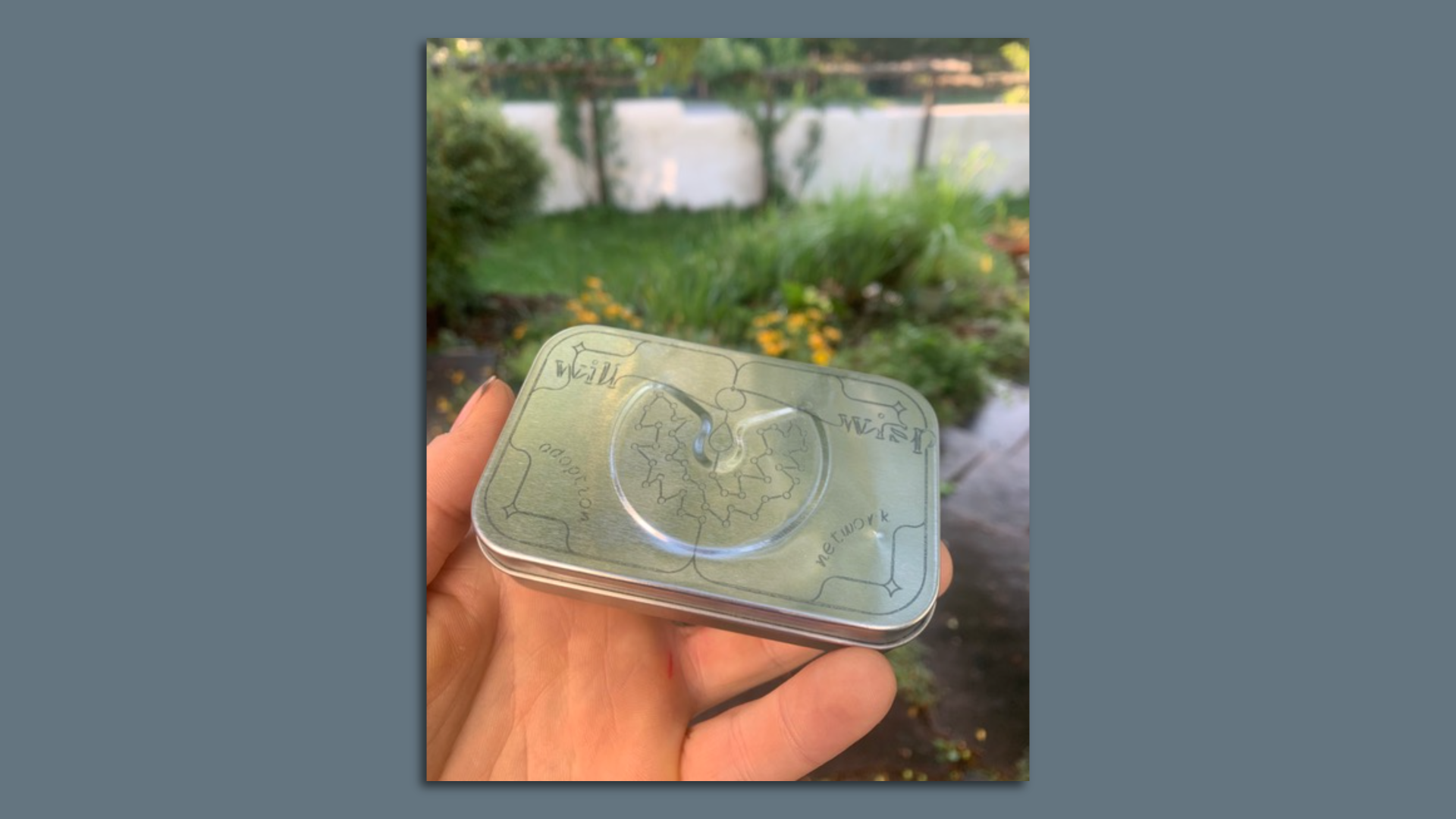
Epstein’s Media Lab research group — called Human Dynamics— is “all about understanding human behavior through the lens of Big Data,” he tells Axios.
- That includes “decision-making and mobility” as studied “through computational methods such as machine learning.”
- “As these gifts are moving around Black Rock City, we’re collecting this data about how they’ve moved,” he said. “The end goal here is a map of the flow of information and gifts across Burning Man.”
- Findings from the experiment — called the Black Rock Atlas Project — “might actually inform the design of social networks and other kinds of stuff,” he said.
Epstein and fellow “Burning Nerds” will spend the week in a science-themed camp, where they’ll give TED-style talks about their research in a massive geodesic dome.</span

Ask a scientist on the left (I’m in there somewhere and so is one of my current roommates– another Caltech PhD ’13.) Science class on the right. Science everywhere!
- “People will just stumble in from the desert and completely randomly bump into this conversation, this talk, about — I don’t know, geometry or DNA or space plants,” Epstein said.
- Like the event itself, the talks are a juxtaposition of high-mindedness and survivalism: “It’s a very harsh environment, and staying alive and hydrated is a big part of that.”
The big picture: The 36-year-old festival— where people create fantastical artworks and ride bicycles festooned with LED lights — is a sociologist’s delight.
- Burning Man’s organizers have long supported academia and maintain a list of scholarly papers drawn from the event.
- The most prominent was a study published in Nature Communications in May that sought to gauge the “transcendence” of the experience.
-
- Researchers calibrated the ability of mass gatherings to generate feelings of “collective effervescence,” (HIVE MIND) a term coined by French sociologist Emile Durkheim.
- They found that “63.2% of participants reported being at least ‘somewhat’ transformed, and 19.5% said they were ‘absolutely’ transformed.”
The backstory: Epstein and his colleagues first attended Burning Man in 2018, when they brought 15 poster-tube-sized “vessels,” each with someone’s name and picture inside — to see if the community could convey the tube to its owner.
- That didn’t quite work, so this time they started from scratch.
- “You want to do something that’s scientific and rigorous and gives you good data to make inferences,” Epstein said. “On the other hand, especially at Burning Man, if it’s boring and not very fun, people aren’t going to participate.”
Between the lines: They’re not the only ones trying to blend art and science — and escape quotidian realities— at Burning Man.
|
Quotidian – Definition, Meaning & Synonyms |
- Ryan Sobel, a financial adviser from Denver who’s attending for the first time, is part of a 27-person group that got approval for a new camp called “Consensual Abduction.”
|
|
| Abduction is considered to be the illegal holding or transporting of a person without consent and against his or her will. Most instances of this crime include force, threats against the victim, intimidating the person usually through proposed violence or through words or some sort of deception. Abduction is considered to be when a person has been taken away from his or her original location by persuading him or her, by some act of fraud or with a forceful way that may include violence. SOURCE |
| In my opinion Consensual Abduction is an oxymoron. Though one may submit to abduction out of fear, that can hardly be construed as giving consent. |
- They’ll build a fire pit, a “wormhole” for guests to slide through, and a dance floor for all-night raves.
- For the event, Sobel, the group’s bartender, learned to make fluorescent cocktails using Vitamin B2. “We’re going to have drinks that glow, and flashlights,” he said. “This will be fun.”
The bottom line: Pent-up demand for fraternity, sorority and debauchery are likely to make this year’s Burning Man particularly creative and memorable.
- “It’ll be a very interesting time,” Epstein said. “Just like with everything in the pandemic, cultural traditions kind of dry out and then get rebooted.“
Harnessing the Power of Sacred Geometry
We live in exciting times where modern minds are bridging that mysterious borderland between the visible and invisible. At the intersection of where science and the unseen merge, ancient knowledge of how to harness the power of Sacred Geometry is once again reemerging within the collective consciousness. We are re-discovering the properties of frequency, vibration and resonance, and how these invisible – yet, powerful forces affect the very fabric of our reality.

Welcome to the mind-bending world of Sacred Geometry– one of the few subjects that appeals to left brain and right brain at the same time!
Sacred geometry is woven throughout the fabric of creation. It is the invisible architecture of creation; and, one might add, the stamp of the cosmos. Once we understand how it all works, we have the tools we need to live more balanced, extraordinary lives.
Sacred geometry ascribes symbolic and sacred meanings to certain geometric shapes and proportions. It is associated with the belief that an Intelligent Universal Force of Consciousness is the grand Architect of the Cosmos. This ancient language describes a definite order of physics – how everything works.
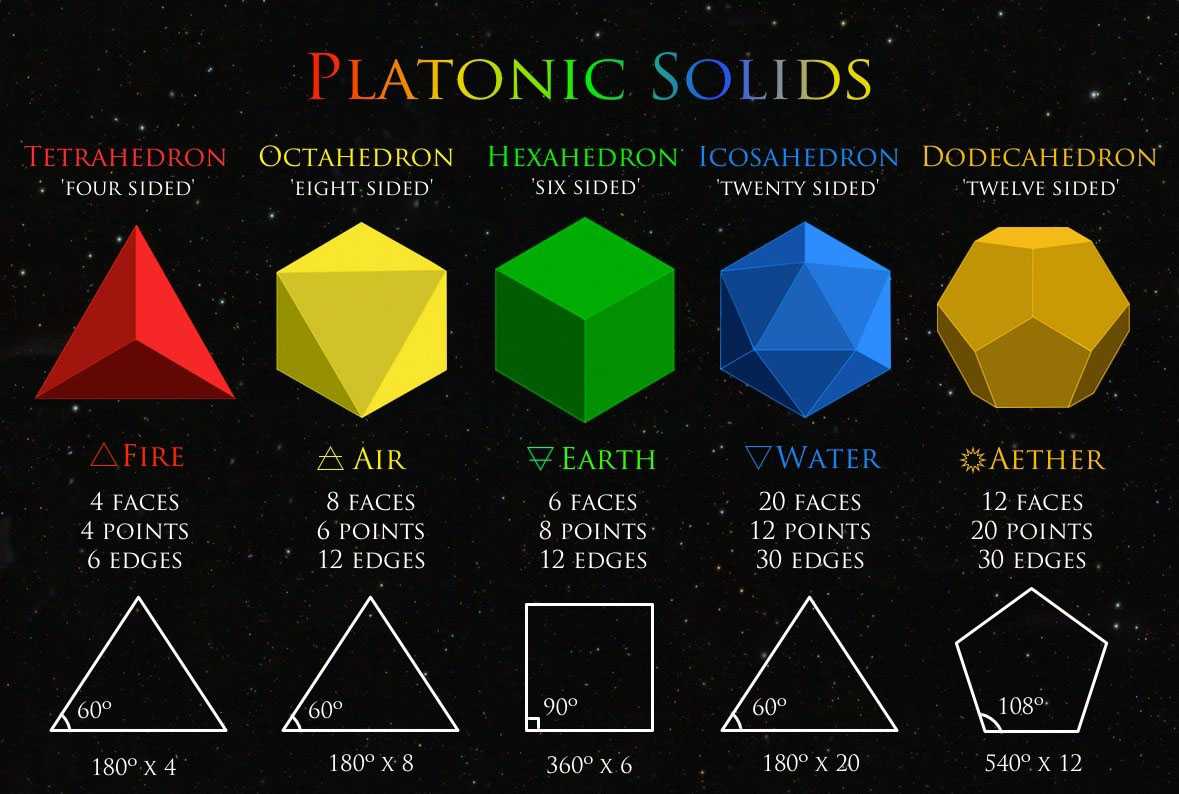
The Sacred Geometry of Domes mimics the fundamental shape of creation – the sphere. Atoms, molecules, the earth, sun, stars, moon, etc. are all spheres which mathematically generate a point at the center that creates stillness, also known as the Bindu point in ancient meditation practice. This is why yoga has found its perfect home in a sacred geometry dome.
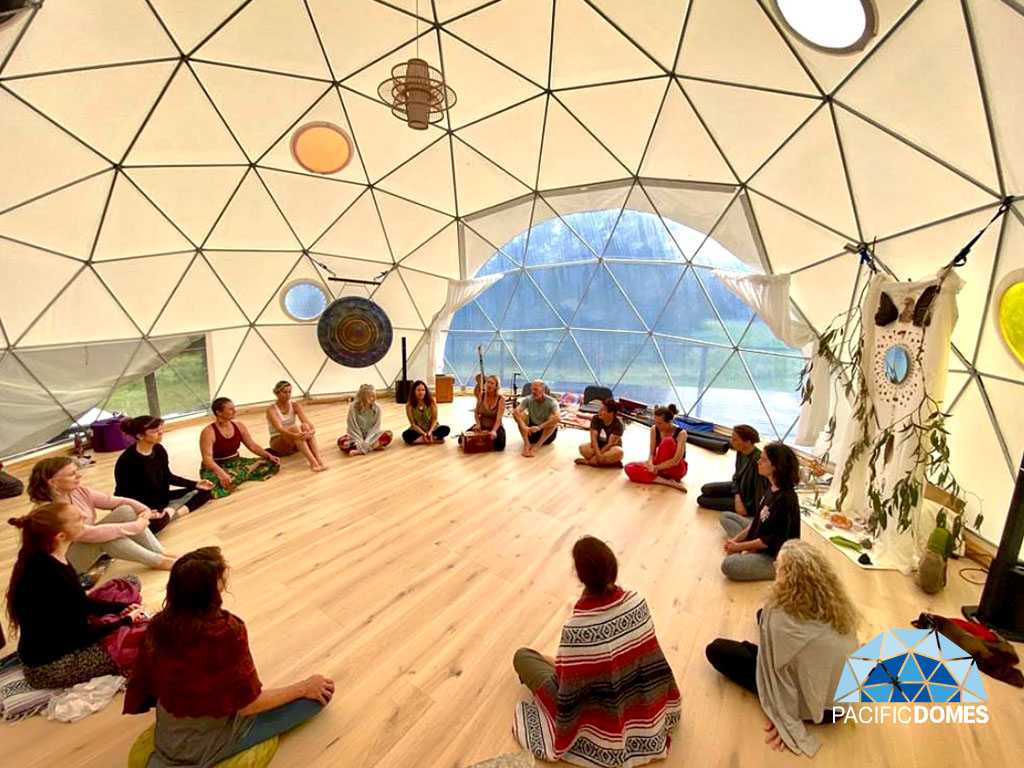
Many healers use domes because they believe that this harmonic architecture helps reorganize the cells of the body, helping to improve health and creativity. Domes are an enlightening experience to live and play in!
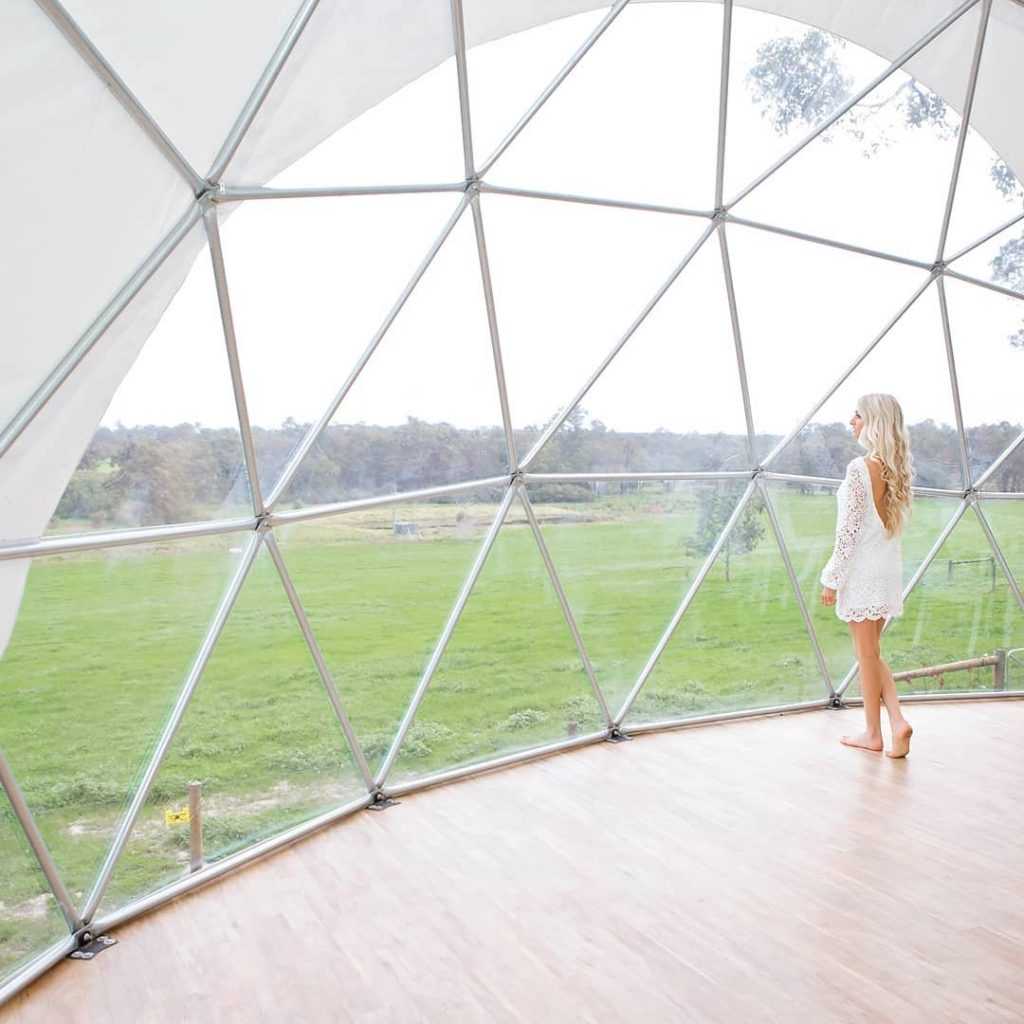
Spending time in a dome raises our vibration and touches a deep harmonic chord in our soul.
The Invisible Harmonics In Space: The Subtle Energy Field
There is scientific data to back up the idea of the human bubble being the electromagnetic field and the numerous subtle energy bands of the aura, morphological fields, and others, with their poles and vortices and veritable nodes and ley lines of power current. We’ve all heard the saying “you’re invading my bubble!”, referring to someone who is standing just too close. Just like earth has a field, so does each and every living thing – humans included.
In terms of quantum physics, everything is made up of energy, from the quarks and sub atomic particles to the most immense megalithic structures or complex machines. It’s not only living things that possess energy – places are no exception.Spaces possess specific energetic qualities and areas of good or bad energy flow. For example: buildings, rooms, gardens, you name it – everything has a unique energetic signature at every level of the micro/macrocosm. It all has to do with attunement and harmonics.
First “SCIENCE” called all these thing HOOEY, Superstition, and MumboJumbo. They got everyone to put the “Faith” in science and turn their back on GOD. Now they are reintroducing all things spiritual and metaphysical and calling it SCIENCE. In order to maintain CONTROL over the hypnotized masses.
BE AWARE that they have been using electromagnetic waves, frequencies, radio, radiation, lasers, and chemicals to destroy our bodies and our environment. They have developed any number of tools to control your mind. Now that they have your mind all mapped out and they have your DNA filed, labeled and mapped, they know just how to manipulate and control each individual.
YOGA is the gateway that opens you up to DEMONIC POSSESSION.

Harnessing Divine Energy Flow
Once you understand that the flow of energy around you marks the blueprint of your happiness, you know why keeping an orderly and beautiful dome home brings such a sense of peace. The only true peace comes from the PRINCE OF PEACE. You can have peace no matter where you are or what conditions you find yourself in, if you KNOW GOD.
As the conscious mind rests and relaxes with the subtle harmonic tones found within each dome, the mind is cleared and quieted. This has the ability to put you in a theta state, allowing you to use your power of imagination to create a Dome of Protecting White Light,leading to higher states of consciousness.
What a CROCK of NEW AGE NONSENSE!
Theta Brain Waves Theta brain waves can also occur when you’re awake,but in a very deeply relaxed state of mind; a state that some may describe as “autopilot.Theta activity has a frequency of 3.5 to 7.5 Hz and is classed as “slow” activity. Theta waves are strong during internal focus, meditation, prayer, and spiritual awareness. It reflects the state between wakefulness and sleep and relates to the subconscious mind. It is abnormal in awake adults.
It is a state where tasks become so automatic that you can mentally disengage from them. |
THAT IS WHERE THEY WANT TO KEEP YOU!! Any way they can get you there. Your mind is wide open and a truly inviting spot for demons to move right in.
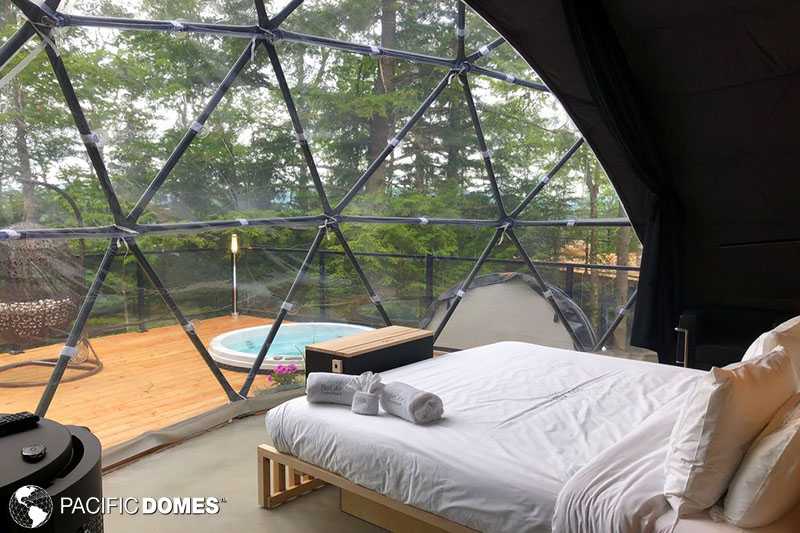
Are We Living in Harmony with Nature?
Are we living in a manner that magnifies our connection to the Universal rhythm of life? Creating a harmonic living environment specifically designed for our Soul’s nourishment is paramount to happiness and our evolution as Cosmic Beings. They have mesmerized the masses into believing their alien/Fallen Angel version of the Cosmos. Little mind love to be entertained. They love fantasy and mystery and whimsy. They love to lose themselves in drugs, dreams and imaginations full of imaginary friends.
|
7 days ago — The meaning of COSMIC is of or relating to the cosmos, the extraterrestrial vastness, or the universe in contrast to the earth alone.
|
| cosmos (n.) |
spacer
The choices we make form the architectural blueprints of the psychic space that surrounds us. This psychic space then becomes the soil that nourishes the roots of our Spirit. Just as the quality of a fruit depends upon the seed, the soil, the weather and the connection to the master gardener – so too, does our quality of life depend on our energetic backdrop.
YOUR QUALITY OF LIFE depends on your connection to the LIFE GIVER. Whether you want to hear that or not. THERE IS ONE AND ONLY ONE SOURCE OF LIFE and that is the ALMIGHTY CREATOR GOD. Everything not connect to him IS DYING!!
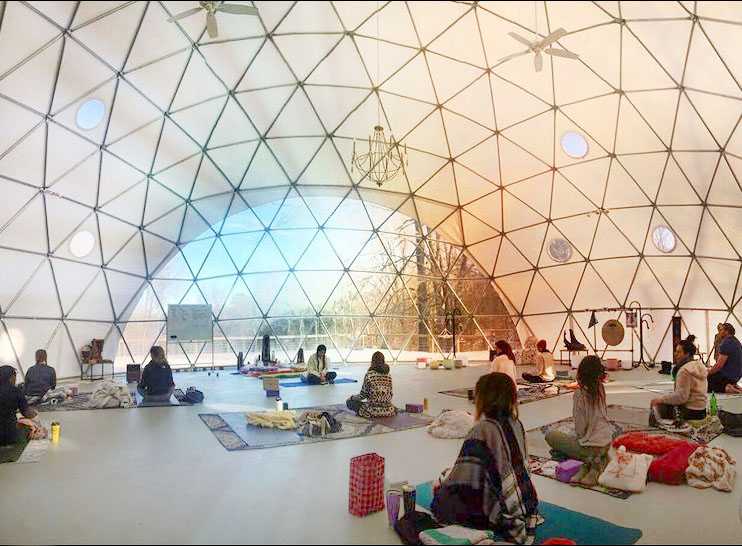
In Summary
The Universe is an orchestra of sound, and music is its universal language. The harmonics created by the energetic qualities of dome architecture amplifies our connection to Spirit, maximizes our potential, and heightens our everyday threshold of harmony and bliss.
I used to think that Music was a great tool for reaching people because it bypasses the brain. However, you must understand that LUCIFER was the music leader in heaven before the fall. His whole being is made up of instruments. He controls the MUSIC here on earth. He is using his knowledge of notes, harmonies, frequencies, and melodies against humanity. It is a trap. BEWARE! WAKE YOU SLEEPER and shake it OFF!
Greater understanding allows us to tap into the power of, and to be in harmony with, the Universe. And even if we don’t understand it — for indeed, it is a deep scientific mystery — we can use its power to enhance our lives and be humbled and grateful in the face of it.
If you’re feeling like your reality could use a cosmic re-tuning, why not open yourself up to the divine principle behind it all? Pacific Domes invites you to Take a tour of our Domes around the world!
When they talk about divinity, or the devine, or they refer to the great architect, or to GOD. They are not referring to the ONE TRUE LIVING ALMIGHTY CREATOR GOD. They are referring to the gods of mythology and pagan religions.
Scientists and the ruling elite believe themselves to be divine gods!! With the divine right to RULE OVER YOU!
Geodesic Festival Domes of Burning Man
Pacific Domes of Oregon, leading builders of Geodesic Structures for use as Outdoor Event Tents, Outdoor Shade Canopies, and Event Tents for Rent.
In recent years domes at Burning Man have been a hit. They’re portable, easy to install and are strong enough to handle the sandstorms and heat of the desert. If you’re looking for a suitable dwelling space, maximum shade from the sun and a vibrant way to showcase your artistic side at Burning Man then you need to have a dome.
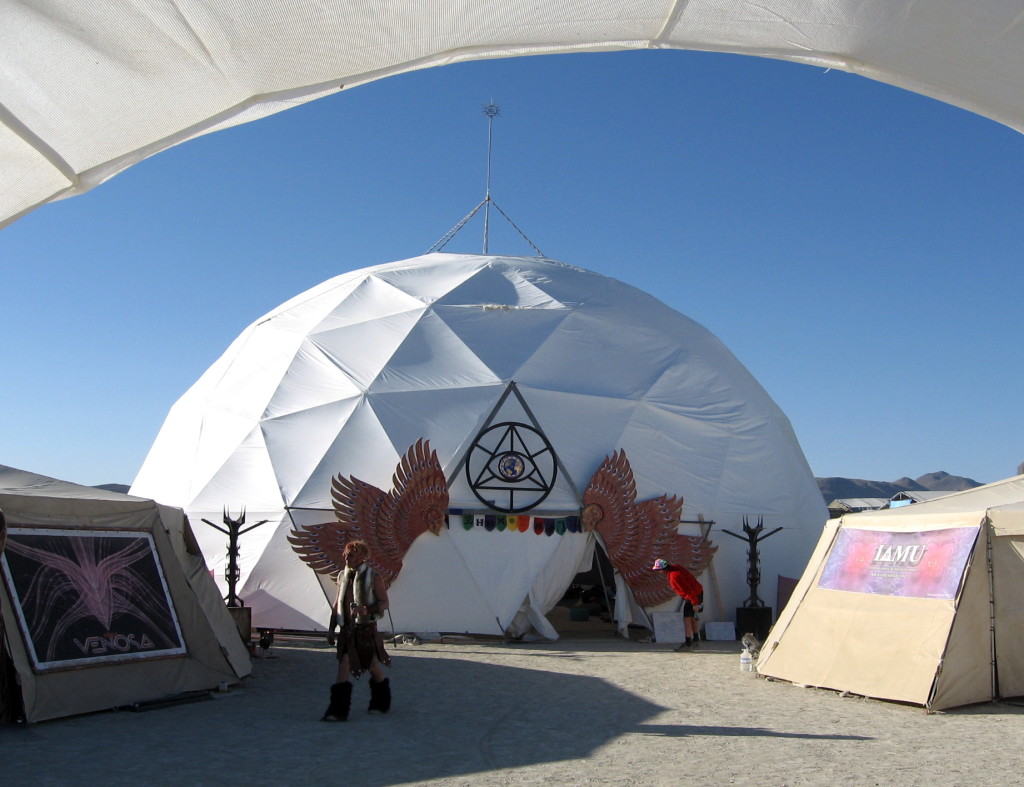
One of the stunning elements we’ve implemented in the past is airbrushing. The colors are absolutely magical and add life to the already profound architecture of the dome. They are not joking folks and they know it. Colors, sounds, light, geometric shapes are all tools used by witches and shamans to manipulate your mind. They are used in all the spells and curses used on you by the ruling elite. All the sights and symbols at BURNING MAN are part of the spell.
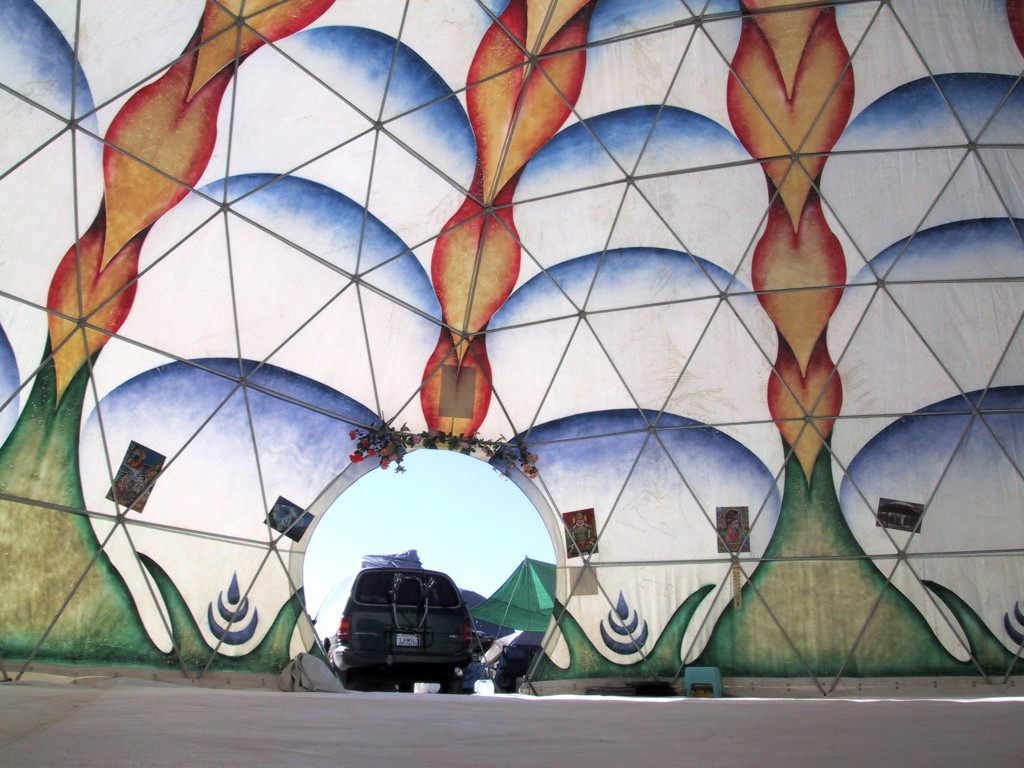
Burning man is all about self-expression and what better way to express yourself than accommodating a personalized and decorated structure with its own harmonic festival energy. Thousands of people have found themselves dancing the night away under the cover of a dome, lost in the atmosphere of Burning Man.
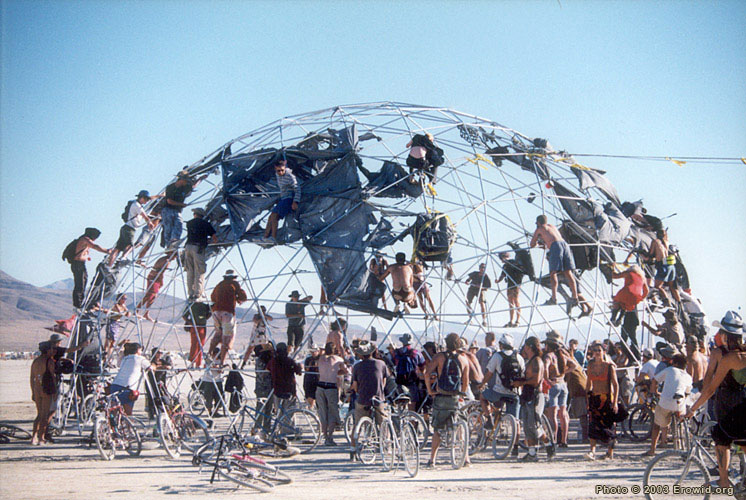
 Wow, I just noticed that logo. I reminded me of the land formation at the waterfront at Obama’s Edgartown, Martha’s Vineyard property, WHERE TAFRI CAMPBELL WAS SACRIFICED. I have never seen the Burning Man logo with the flame on each side like that before.
Wow, I just noticed that logo. I reminded me of the land formation at the waterfront at Obama’s Edgartown, Martha’s Vineyard property, WHERE TAFRI CAMPBELL WAS SACRIFICED. I have never seen the Burning Man logo with the flame on each side like that before. On their page called connect and collaborate, find it under the menu, you will see the pic shown on the right. It is believe it or not, a BURNING MAN OCTOPUS. What do you think of that. Actually, it resembles the SQUID much more. If you have been following my posts you should be well aware that the OCTOPUS is the symbol for SURVELILLANCE, the all seeing eye, AND THE NWO TOTAL CONTROL. THE SQUID IS THEIR NEW MASCOT. STILL EIGHT LEGGED BUT WITH SO MANY MORE “SUPER POWERS”.
On their page called connect and collaborate, find it under the menu, you will see the pic shown on the right. It is believe it or not, a BURNING MAN OCTOPUS. What do you think of that. Actually, it resembles the SQUID much more. If you have been following my posts you should be well aware that the OCTOPUS is the symbol for SURVELILLANCE, the all seeing eye, AND THE NWO TOTAL CONTROL. THE SQUID IS THEIR NEW MASCOT. STILL EIGHT LEGGED BUT WITH SO MANY MORE “SUPER POWERS”.
Burning Man is a network of people inspired by the values reflected in the Ten Principles and united in the pursuit of a more creative and connected existence in the world. Throughout the year we work to build Black Rock City, home of the largest annual Burning Man gathering, and nurture the distinctive culture emerging from that experience. The hub of this global network is the 501(c)(3) non-profit Burning Man Project, headquartered in San Francisco, California.
Mission Statement
The mission of Burning Man Project is to facilitate and extend the culture that has issued from the Burning Man event into the larger world.
For the mission of Burning Man, head here.
Vision
Burning Man Project will bring experiences to people in grand, awe-inspiring and joyful ways that lift the human spirit, address social problems, and inspire a sense of culture, community, and civic engagement.
Program Areas
Burning Man provides infrastructural tools and frameworks to support local communities in applying the Ten Principles through six interconnected program areas, including Arts, Civic Involvement, Culture, Education, Philosophical Center, and Social Enterprise.
Burning Man Project
Burning Man founders have been discussing the concept of the non-profit Burning Man Project since the 1990s. In 2011, organizers took the first step in creating a non-profit, forming a 16-member board consisting of the founders and burners with backgrounds in non-profit, arts, business and civic realms. Burning Man Project received its 501c3 status as a charitable organization in May 2012 and in the 19 months since then, the project has developed three primary areas of focus: outreach, building the business structure and testing demonstration projects.
Our outreach efforts are tailored to support the work of like-minded organizations and educate burners and the general project on the Project’s mission. We’ve done this locally and around the world with participation in Earth Day events, regional burns, at Everywhere Pavilion on the playa and as part of local community events like HeArt of Market in San Francisco.
In Black Rock City, we share space in the Everywhere Pavilion with Black Rock Arts Foundation, Burners Without Borders, the Regionals and Black Rock Solar. It’s a great opportunity to discuss our plans for the future with participants and learn from your experiences in showcasing Burning Man culture around the world.
We’ve also begun building out our programs – thinking through how to replicate workshops and demonstration projects while creating new programs like video training through our Education program. And we’ve been building our business structure – carefully considering the practical and philosophical aspects to determine what’s functional and works with our culture.
As a non-profit, we’re raising money to build capacity to support our programs and the process of fundraising is something we need to align with our values. In 2013, we conducted several fundraisers – including the well-received “This is Burning Man” talk with Larry Harvey, Danger Ranger and Brian Dougherty, author of the book “This is Burning Man.”
One of our goals for 2014 is to expand our partnership program,where we support like-minded organizations. (There is that Phony Philanthropy) We did it this year with [freespace], which started in San Francisco and was recognized by the White House for its innovative approach to community building, and is now spreading worldwide.
We also want to expand our collaborative demonstration projects. In 2013 we collaborated with Downtown Project via a consulting services agreement to bring art and civic programming to support DTP’s revitalization work in downtown Las Vegas. Y.E.S. – the Youth Educational Spacecraft – is another demonstration project that continues to land in communities around the U.S. Like-minded organizations like Black Rock Arts Foundation, Black Rock City, the Crucible, Exploratorium and Maker Faire contributed time and money to support this mobile art project and classroom so kids from Boys & Girls Club, local schools and burner families could imagine and create their visions for outer space. Y.E.S. has landed most recently in Las Vegas for an extended tour – allowing more kids from public schools to engage with our culture. Is Burning Man Culture really something to which we want our children exposed?
In the long term, we view ourselves as a service provider to people and organizations extending Burning Man culture globally. As we build capacity, we are testing ideas locally to determine whether they are replicable in other communities.
All of us with the Project are looking forward to the new year and new adventures with all of you!
Submitted by,
Heather White
Financial Structure
In 1997, it became apparent that Burning Man needed to create some kind of legal entity to do business in the world.(got to keep that money flowing free and out of the hands of any governments, don’t want to support nationalism. And if we can get free tax money and endorsements at the same time Hallelujah) As Black Rock City continued to grow, no single organizer could be expected to personally assume the legal and economic risks that were created by an event on this scale.
Our chief organizers briefly considered forming a non-profit, and we have recently helped found the nonprofit Black Rock Arts Foundation in order to support the efforts of our community’s artists. As lifetime activists, however, we felt uneasy with the legal structure such an entity would impose on the project.Nonprofit status requires that a board of directors be created to assume responsibility for the organization. (Sure don’t want any restrictions, or anyone looking over our shoulder or holding us accountable. Nuts to that. Especially with all the drugs and other illicit activities at the Events.)
In particular, it becomes the fiscal duty of this body to ensure that all funds be applied for purposes that can be said to benefit the public welfare. (Oh, naturally, that is absolutely their motivation at all times, the public welfare! Right!) This presented no problem to us. Burning Man has always operated in an altruistic fashion. (They really expect anyone to believe that? Well, besides all the Burners whose minds are BURNED) We’ve spent a far greater portion of Burning Man’s income philanthropically than the average nonprofit. (Phony Philanthropy, we know all about how that works, that is just the Rich money laundering. I scratch your back you scratch mine an we all get wealthier than ever.)
If anything, we joke, we are more aptly termed a “no-profit”. We have never had investors. We accept no commercial sponsorships, endorse no products, and we have disallowed vending except for the sale of coffee and ice at the event. All of these activities are typical sources of income and funding for a normal business that exists to create a profit. (Ya, above board and accountable. You guys developed a better way. You only deal with other “charitable” institutions and educational institutions, civil organizations and NON GOVERMENT Organizations. Where money, goods and people flow freely with no interference.)
Nonprofit status, however, is a tax category, and strict rules apply to what is called “self dealing”.This means that a nonprofit entity cannot exist for the purpose of enriching its directors. We had no difficulty with this concept. None of us have been particularly financially enriched by this enterprise. Our problem, however, was that we could not afford to work at guiding and creating Burning Man without being paid. (Ya, cause it costs money to promote the AGENDA and re-educate the masses, and build the New World Global Economy.)
The Project requires a yearlong effort and, for many of us, a normal workweek often exceeds forty hours. We could have stayed on as hired managers of a nonprofit and ceded ultimate authority those who could be deemed “disinterested”, but we are a society of activists (activists with an agenda) who are very interested in guiding the essential mission and purpose of Burning Man. A governing board made up of non-participants who are detached from the day-to-day toil of creating a community seemed inappropriate.
We elected, instead, to form an LLC, a limited liability company. This, in our case, is essentially a partnership of managers that confers the status of a corporation. The members of what is now called Black Rock City LLC are co-owners of an enterprise.As a private corporation – and unlike a nonprofit — this entity pays taxes. As a corporation, however, we are also granted certain legal rights and protections. The company that rents portable toilets, applies for permits, signs contracts with businesses, maintains a bank account, and is represented by lawyers is Black Rock City LLC.
By the year 2000, however, it also became apparent that if Burning Man were to survive, we also needed to acquire property. For years we had grappled with the perennial dilemma that besets the poor: if one hasn’t any money, everything is dear. Rented equipment, for example, costs much more over time than goods that are purchased. Even more urgently, we needed to acquire other kinds of property.
We could not afford to buy an office space in San Francisco and thus have remained renters. Acquiring property on which to permanently locate the workshops, housing and storage facilities that are needed by our community, and by our Department of Public Works, remained a high priority. Finally, in the spring of 2001, we purchased a 200-acre tract, now called Black Rock Station, utilizing income we received from ticket sales that year.
Because of the many restraints we have placed on money making,Burning Man has never earned a significant profit. Tickets sold early in the year following an event immediately fund critical activities early in the next yearly cycle. The following financial report will also make clear that this is still true this year.
We have always talked of creating a “nest egg”, a capital fund derived from profit that could be invested and put aside as a buffer and potential source of emergency funds, but we have never been able to achieve this goal. In purchasing land in 2001, however, we acquired assets.
This idea of assets was for us a kind of novelty (unless one counts several dozen semi-derelict vehicles and trailers that have been housed on the 80 rented acres we have occupied immediately adjacent to this new property). As described in the Department of Public Works section of this report, we also undertook to improve this land, creating further assets.
Our purchase of Black Rock Station created a new problem for the organization. According to the laws of Nevada regulating the operation of LLC’s, the members of our board owned equal shares of this new capital asset, and, like any property, it was alienable. It could be sold and traded like any other sort of commodity. This made all of us uncomfortable, and, in response, we invented a very unorthodox agreement.
We decided that any assets that the partnership acquires would be deemed non-transferable. If any member of the LLC dies or elects to leave the partnership, their interest cannot be transferred or sold to another party.Whoever leaves will lose all right of ownership. In other words, we have annihilated equity.
Should any member of the LLC depart, he or she will receive, as sole compensation for many years of service, a golden parachute of $20,000. Their share will then revert back to the group. It is also our intention to continue to recruit new LLC members over time from trusted colleagues within our organization.The LLC will not become what is called a “tontine”, a form of partnership in which all assets can revert to a surviving member. In effect, the property of this corporation will not belong to independent individuals, so much as to the culture of Burning Man.
I have told this story because I am proud of my colleagues for doing this. But I also relate the story because it demonstrates a basic principle. We have never imagined that Burning Man is or should be property in any ordinary sense of the term. Everyone feels that the Project should not be treated as a commodity. The idea that any one of us might possess the right to transfer these assets onto the market felt aberrant.
We’ve labored so long in the radically de-commodified world of Burning Man that this agreement represents a form of common sense.Millions of dollars may stream into Burning Man each year, and millions may flow out, but Burning Man is not for sale.
Submitted by,
Larry Harvey
spacer
One has to understand that the Burning Man Festival and all that is done and consumed there is not the commodity and never was. The commodity is the EXPERIMENT and all the data collected there as well as all the opportunity for programming and brainwashing the people who attended in order to to promote the AGENDAS of the New World Oder and the powers that are behind it. The events are just the vehicle.
spacer
The Network
Regional Network
The Burning Man Regional Network plays a key role in the year-round extension of the Burning Man experience, supporting it as a global cultural movement. In cities around the world, Regional Contacts help local Burners connect with each other, while bringing Burning Man principles and culture into their local communities through events and activities, year-round. Find and get in touch with your closest Regional!
ACCESS THE INTERACTIVE MAP: CLICK HERE![]()

Global Regional Directory | About the Regional Network | Become a Regional Contact
Official Regional Event List | Regional Event Calendar
There’s So Much More to Burning Man Than Sex, Drugs and Debauchery
 spacer’
spacer’ 
spacer

The new firm will stand on a bedrock of GE’s solar business launched by GE executive Erik Schiemann in 2012. He launched GE Solar as a nimble startup looking to design and build renewable onsite energy solutions for customers. Today, the business has more than 60 employees — with a collective experience exceeding 3 gigawatts — that have developed more than 125 solar-power sites for customers in industrial, commercial and government sectors. GE will retain 20% of the business; BlackRock takes an 80% stake. The BlackRock deal is intended to put Distributed Solar Development, or DSD, in a good position to build on the demand for new distributed solar generating capacity. Indeed, DSD has ambitious growth targets. Currently, it builds about 100 megawatts of on-site solar projects each year; in five years, it hopes to quadruple that project pipeline.“BlackRock Real Assets will supercharge this development expertise with capital.The firm, which manages $6 trillion in assets, operates one of the largest renewable power equity investment platforms in the world with $5 billion invested in over 250 solar and wind projects across the globe, with a total generation capacity of over 5.2 GW. “This investment will deepen our clients’ access to the tremendous growth potential in the U.S. solar industry,”says David Giordano, global head of renewable power at BlackRock. “DSD offers end-to-end in-house capabilities and a strong team of experts from across the commercial and industrial value chain. We look forward to working with the DSD team to capitalize on the development opportunities presented by the growing interest in renewable energy on behalf of our clients.”Operating as a standalone company will also streamline DSD’s operations. “Separating ourselves from GE in this fashion means I can now do things more simply, with lower costs of capital, lower transaction costs, [greater] speed to execution and kind of that one-throat-to-choke from our customers’ perspective,” Schiemann says.When DSD got started seven years ago, the market for on-site solar power plants was served mainly by local solar firms that sometimes promised more than they could deliver. The prevailing business model was centered on building installations that customers would finance and own. The idea behind DSD was to lower the relatively high barrier to entry. By bringing GE’s resources to bear, DSD sought to provide consistent, high-quality soup-to-nuts service that would make solar a slam-dunk decision. DSD would not only build and operate solar installations for its customers, but also finance them and retain ownership, and early success provided proof of this concept. Schiemann recalls getting wind of a paper manufacturer, just north of New York City, that was looking to supplement its energy supply with on-site solar energy. “First we focused on whether we could build an on-site solar field for them. Then we went ahead and figured out how to do it (as a business).”Once the deal went through, employees at competing energy development firms began to reach out to Schiemann to see what GE was up to. “People in the market started to say, ‘Wow, you might be on to something,’” he says.From the beginning, DSD was not a standard GE venture. It offered to put together optimal solutions for its customers even if that meant using products not manufactured by GE. It had no factories or big service contracts. Some executives saw distributed solar power as a threat to the traditional power business, which has been based on a hub-and-spoke model of energy transmission ever since GE and its customers pioneered it a century ago. “There was a lot of debate about what I was doing,” says Schiemann. “I argued that if we don’t try to disrupt our own business, someone else will.” He got it right. Schiemann’s customers, in the end, wanted the benefits of having a power source on-site, tailored to their needs, requiring no large capital outlay. When Home Depot agreed to allow DSD to build more than 10 megawatts of solar plants on its East Coast stores, the logic of distributed power was well on its way to becoming mainstream. Now it’s conventional wisdom. Top image credit: Distributed Solar Development
Brookfield and BlackRock are betting big on tiny solar farms in Chile
Model offers guaranteed long-term prices for power produced by tiny renewable plants
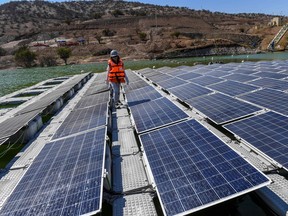
Article content
Some of the world’s biggest fund managers are piling in to a quirky Chilean business model that offers guaranteed long-term prices for power produced by tiny renewable plants.
The money flowing in to PMGDs is part of a clean-energy boom in Chile,with the South American nation’s abundance of wind and sunshine helping it top BloombergNEF’s ranking of most attractive emerging markets for renewable investments. But like other markets, transmission investments haven’t kept up with the generation boom. PMGDs afford some protection from the ensuing bottlenecks and price distortions.
“Foreign interest in Chile’s renewable energy projects through these small units is on the rise as they have demonstrated to be stable and leverageable,” said Jonathan Huckaby, partner at Hudson Bankers, one of the advisors behind the most recent portfolio purchase from BlackRock.
BlackRock expects to reach 450 megawatts of capacity at small generators by 2024. Its most recent acquisition included 11 solar projects totalling about 100 megawatts from D’E Capital and another 100 megawatts in 15 projects from Renewable Resources Group. Brookfield is also looking to step up investments, said a person with knowledge, who isn’t authorized to speak
spacer
BlackRock Real Assets has acquired National Renewable Solutions (NRS), a Minneapolis-based renewable energy developer focused on early stage wind and solar projects in the US.
BlackRock has bought 100% of the equity in NRS,with a goal of developing, owning, and operating the company’s current project development pipeline of more than 3.5GW,with assets in New Mexico, Colorado, Arizona and Nevada.
Founded in 2011, NRS has developed over 1GW of renewable energy projects that are currently operating or are entering construction this year.
The company has historically focused on pre-construction development of utility-scale wind projects, as well as distributed and utility-scale solar, primarily in the western United States.
Part of NRS’s mission is a commitment to help revitalise rural communities by promoting investments in domestic renewable energy resources that benefit local landowners.
This investment, made through BlackRock’s Global Renewable Power team, enables NRS to accelerate its pipeline of projects towards the construction and realization stage over the coming years.
The transaction combines NRS’ on-the-ground development and origination expertise with BlackRock’s capital markets support and global reach. Terms of the transaction were not disclosed.
BlackRock head of the Americas for the renewable power group Martin Torres said: “We are thrilled to partner with NRS on this exciting opportunity and look forward to supporting the company’s strong growth momentum.
“This investment in a developer with an established track record in greenfield projects gives our investors access to significant potential deployment while furthering BlackRock’s position at the forefront of the global energy transition.”
NRS chief executive Patrick Pelstring said: “We are extremely excited to partner with BlackRock.
“We collectively share in the vision to grow renewable energy generation and its integral role in the fight against climate change.
“BlackRock’s investment puts NRS at the forefront of this effortand will allow us to quickly grow into a recognized leader in the development of sustainable and economically viable renewable energy projects.”
BlackRock Real Assets operates one of the largest renewable power equity investment platforms in the world with over $9bn (€7.7bn) in total commitments and investments in 250 wind and solar projects across 13 countries and 4 continents.
GRP III seeks to invest across the spectrum of renewable power and supporting infrastructure globally, including energy storage, distribution and electric vehicles.

BLACK ROCK ARTS FOUNDATION – F.A.Q.
Frequently Asked Questions about the Black Rock Arts Foundation
Download a PDF file of our FAQ.
Frequently Asked Questions
What is the mission of the Black Rock Arts Foundation?
- The mission of the Black Rock Arts Foundation is to support and promote community, interactive art and civic participation.
Who founded the Black Rock Arts Foundation?
- The Black Rock Arts Foundation was founded by several of the partners who produce Burning Man, an annual arts festival in the Nevada desert.
- BRAF was established to promote and support highly engaging, collaborative and accessible public art, akin to the work experienced at the Burning Man event, bringing this new genre of art to communities worldwide, “the other 51 weeks of the year”.
- Because BRAF works beyond the borders of Black Rock City, the foundation was established as a separate identity and organization.
Why was it founded?
- In response to the lack of free, accessible art in the public, and to promote community-based exhibitions of socially interactive art.
- To be a dedicated source of funding of interactive art.
- To support the artists and art organizations affiliated with the Burning Man community.
- To share the art we’ve come to know and love with other communities.
- To create a movement of public art that invites interaction and personal relationship with the artworks.
- To provide ways for artists to connect with audiences outside of traditional arts institutions.
When was it founded?
- The Black Rock Arts Foundation was established in May of 2001. The foundation applied for its 501(c)(3) status in July of 2001 and received it in November of 2001. Our Federal Tax Exempt ID number is 91-2130056.
On May 8, 2001, The Black Rock Arts Foundation was founded as a separate nonprofit to promote Civic engagement and to help fund Interactive art. Source
What is ‘Interactive’ Art?
- For our purposes, interactive art means art that generates social participation. The process whereby this art is created, the means by which it is displayed and the character of the work itself should inspire immediate actions that connect individuals to one another and to their community.
What are our Values?
- Interactivity – We value art that prompts the viewer to act. We like art that can be experienced in more ways than visually. We are fans of art that is meant to be touched, heard or experienced, as well as viewed; art that requires human interaction to complete the piece, that prompts people to interact with one another, that responds to participants and to its environment.
- Community – We value art that builds community through education, collaboration and activism. We see that when an art project arises from the need of a community, it belongs to the public and exists for the benefit of all. When a work is freely accessible to the public, civic in scope and inclusive by nature, it challenges the traditional perspectives on art. When an interactive artwork becomes part of a community, it demands the stewardship of its citizens, engendering ownership, responsibility and pride.
- Education – We value art that goes beyond artistic expression; we value art that educates.We support projects that prioritize collaboration with local youth and educators. We know that, with guidance and support, the creation of art is a most powerful tool to educate youth about the pressing concerns of their times,including issues around the environment, renewable energy, and climate change.
- Activism– We value art that causes people to reflect on the larger community. We see art as a way to connect individuals, and call them to action.We commend art that challenges individuals to reexamine their everyday lives and their role in their immediate and larger community. We support art that educates about the alternatives to consumerism and the reduction of environmental impact.Through art, we seek to promote the use renewable resources, environmental justice and social responsibility.
How is Black Rock Arts Foundation funded?
- We receive funds from grants from other foundations and organizations, and from donations from individuals and community groups. Our primary source of funding is donations from individuals.
- BRAF’s past supporters have included the Bill Graham Foundation, the Bains Family Foundation, the Brown Foundation, the Buchheit Foundation, the City of Reno Arts and Culture Commission, the Darby Foundation, the James Irvine Foundation, the Koret Foundation, the La Vida Feliz Foundation, the Leatherback Foundation, the Mental Insight Foundation, the National Endowment for the Arts, the Phyllis C. Wattis Foundation, the Pittman Family Foundation, the Robert B. Hawkins Foundation, the Rock Paper Scissors Foundation, the San Francisco Grants for the Arts Hotel Tax Fund, and the San Francisco Port Commission. (Not an all inclusive list by any means.)
How and where is BRAF legally incorporated?
- The Black Rock Arts Foundation is incorporated as a non-profit corporation in the State of Nevada and has its primary place of business and office at 995 Market St – 9th Floor, San Francisco, California.
- The corporation is also registered as a foreign corporation in the State of California. The corporation filed for charitable 501(c) 3 tax-exempt status with the I.R.S. in July 2001and received its initial determination letter in 2001.
Making prosperity possible for more people, communities and the planet
Bringing economic opportunity to more people
Helping people access a steady and upwardly mobile income is a critical component of building financial security. The BlackRock Foundation supports programs in 14 countries that reskill, provide credentials and create equitable pathways to careers.
00:00-00:04
COVID-19 has wiped out hundreds of millions of jobs globally.
00:05-00:09
And has deepened inequities in communities around the world.
00:11-00:15
That’s why we are partnering with Generation, an organization that trains and connects people to upwardly mobile and sustainable jobs.
00:17-00:24
We will support Generation across 6 countries to help jobseekers access careers in high-demand sectors including tech, healthcare and green jobs.
00:26-00:33
Enabling an inclusive energy transition
The BlackRock Foundation’s $100M 5-year investment in Breakthrough Energy’s Catalyst Program will help bring vital clean energy solutions forward – at scale – to bring the world closer to net zero and mitigate the uneven impact of climate change on communities.
00:00-00:07
Super: Deborah Winshel
Global Head of Social Impact & President of the BlackRock Foundation
In the wake of research showing how many people in the U.S. and the UK couldn’t cover a $400 emergency expense,
00:08-00:13
Super: Deborah Winshel
Global Head of Social Impact & President of the BlackRock Foundation
we launched our philanthropic flagship, Blackrock’s Emergency Savings Initiative, back in 2019.
00:14-00:19
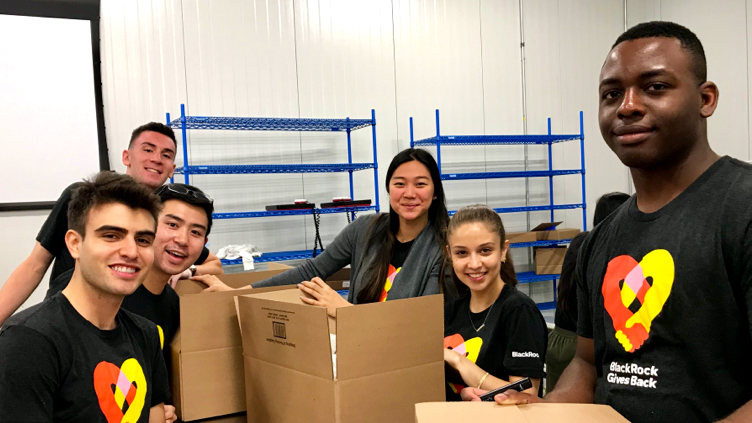
Empowering employees to drive local impact in our communities

spacer

spacer
Burning Man Project – Nonprofit Explorer – ProPublica
ProPublica
BURNING MAN PROJECT
- EIN: 45-2638273
- Classification (NTEE)
Community, Neighborhood Development, Improvement (General) (Community Improvement, Capacity Building) - Nonprofit Tax Code Designation: 501(c)(3)
Defined as: Organizations for any of the following purposes: religious, educational, charitable, scientific, literary, testing for public safety, fostering national or international amateur sports competition (as long as it doesn’t provide athletic facilities or equipment), or the prevention of cruelty to children or animals. - Donations to this organization are tax deductible.
- More Resources:
 GuideStar
GuideStar - Get notifications: Sign up for updates about our data.
Tax Filings by Year
The IRS Form 990 is an annual information return that most organizations claiming federal tax-exempt status must file yearly. Read the IRS instructions for 990 forms.
If this organization has filed an amended return, it may not be reflected in the data below. Duplicated download links may be due to resubmissions or amendments to an organization’s original return.
REMEMBER THIS IS JUST THE FINANCIAL REPORT FOR BLACK ROCK BURNING MAN PROJECT and NON OF GOOGLE’s who owns 51% of the stock. AND NON of the other entities under BLACK ROCK. JUST THE BURNING MAN PROJECT which is supposed to support only the ART and ARTISTS.
2021
Form 990 documents available
Extracted financial data is not available for this tax period, but Form 990 documents are available for download.
| Key Employees and Officers | Compensation |
| MARIAN GOODELL (DIRECTOR/CHIEF EXECUTIVE OFFICER) | $327,006 |
| STEVEN BLUMENFELD (CHIEF TECHNOLOGY OFFICER) | $294,029 |
| HARLEY K DUBOIS (DIRECTOR) | $231,638 |
2020
Total Revenue |
$15,633,807 |
|
|---|---|---|
| Total Functional Expenses | $22,655,698 | |
| Net income | -$7,021,891 | |
| Notable sources of revenue | Percent of total revenue | |
| Contributions | $12,366,591 | 79.1% |
| Program services | $1,960,703 | 12.5% |
| Investment income | $10,737 | 0.1% |
| Bond proceeds | $0 | |
| Royalties | $0 | |
| Rental property income | $6,348 | 0.0% |
| Net fundraising | $0 | |
| Sales of assets | $1,248,374 | 8.0% |
| Net inventory sales | $41,054 | 0.3% |
| Other revenue | $0 | |
| Notable expenses | Percent of total expenses | |
| Executive compensation | $1,963,987 | 8.7% |
| Professional fundraising fees | $226,450 | 1.0% |
| Other salaries and wages | $10,813,239 | 47.7% |
| Other | ||
| Total Assets | $25,058,069 | |
| Total Liabilities | $5,473,595 | |
| Net Assets | $19,584,474 | |
| Key Employees and Officers | Compensation |
| MARIAN GOODELL (DIRECTOR/CHIEF EXECUTIVE OFFICER) | $282,812 |
| HARLEY K DUBOIS (DIRECTOR) | $204,995 |
| HEATHER WHITE (CHIEF OPERATING OFFICER) | $187,855 |
2019
Total Revenue |
$46,414,875 |
|
|---|---|---|
| Total Functional Expenses | $46,064,866 | |
| Net income | $350,009 | |
| Notable sources of revenue | Percent of total revenue | |
| Contributions | $2,217,006 | 4.8% |
| Program services | $43,743,993 | 94.2% |
| Investment income | $53,256 | 0.1% |
| Bond proceeds | $0 | |
| Royalties | $0 | |
| Rental property income | $19,800 | 0.0% |
| Net fundraising | -$119,368 | |
| Sales of assets | $0 | |
| Net inventory sales | $500,188 | 1.1% |
| Other revenue | $0 | |
| Notable expenses | Percent of total expenses | |
| Executive compensation | $2,260,297 | 4.9% |
| Professional fundraising fees | $85,989 | 0.2% |
| Other salaries and wages | $14,001,165 | 30.4% |
| Other | ||
| Total Assets | $31,715,370 | |
| Total Liabilities | $5,109,005 | |
| Net Assets | $26,606,365 | |
| Key Employees and Officers | Compensation |
| MARIAN GOODELL (DIRECTOR/CHIEF EXECUTIVE OFFICER) | $297,128 |
| DAVID BILL (INTERIM CHIEF TECHNOLOGY OFFICER) | $241,866 |
| HARLEY K DUBOIS (DIRECTOR) | $216,197 |
2018
Total Revenue |
$46,641,655 |
|
|---|---|---|
| Total Functional Expenses | $44,041,808 | |
| Net income | $2,599,847 | |
| Notable sources of revenue | Percent of total revenue | |
| Contributions | $2,074,927 | 4.4% |
| Program services | $44,301,800 | 95.0% |
| Investment income | $16,909 | 0.0% |
| Bond proceeds | $0 | |
| Royalties | $6 | 0.0% |
| Rental property income | $20,250 | 0.0% |
| Net fundraising | -$93,833 | |
| Sales of assets | $223 | 0.0% |
| Net inventory sales | $270,572 | 0.6% |
| Other revenue | $50,801 | 0.1% |
| Notable expenses | Percent of total expenses | |
| Executive compensation | $2,365,900 | 5.4% |
| Professional fundraising fees | $0 | |
| Other salaries and wages | $11,978,250 | 27.2% |
| Other | ||
| Total Assets | $30,236,682 | |
| Total Liabilities | $3,980,326 | |
| Net Assets | $26,256,356 | |
| Key Employees and Officers | Compensation |
| MARIAN GOODELL (DIRECTOR/CHIEF EXECUTIVE OFFICER) | $267,687 |
| HARLEY K DUBOIS (DIRECTOR) | $216,204 |
| THERESA DUNCAN (DIRECTOR OF PHILANTHROPIC ENGAGEMENT) | $192,019 |
2017
Total Revenue |
$44,544,045 |
|
|---|---|---|
| Total Functional Expenses | $40,810,169 | |
| Net income | $3,733,876 | |
| Notable sources of revenue | Percent of total revenue | |
| Contributions | $910,635 | 2.0% |
| Program services | $42,816,766 | 96.1% |
| Investment income | $4,681 | 0.0% |
| Bond proceeds | $0 | |
| Royalties | $1,361 | 0.0% |
| Rental property income | $21,777 | 0.0% |
| Net fundraising | $120,651 | 0.3% |
| Sales of assets | $0 | |
| Net inventory sales | $619,882 | 1.4% |
| Other revenue | $48,292 | 0.1% |
| Notable expenses | Percent of total expenses | |
| Executive compensation | $2,032,166 | 5.0% |
| Professional fundraising fees | $0 | |
| Other salaries and wages | $10,135,969 | 24.8% |
| Other | ||
| Total Assets | $27,772,267 | |
| Total Liabilities | $4,115,758 | |
| Net Assets | $23,656,509 | |
| Key Employees and Officers | Compensation |
| MARIAN GOODELL (DIRECTOR/CHIEF EXECUTIVE OFFICER) | $261,032 |
| LARRY HARVEY (PRESIDENT) | $210,608 |
| THERESA DUNCAN (DIRECTOR OF PHILANTHROPIC ENGAGEMENT) | $186,521 |
2016
Total Revenue |
$46,218,471 |
|
|---|---|---|
| Total Functional Expenses | $36,975,805 | |
| Net income | $9,242,666 | |
| Notable sources of revenue | Percent of total revenue | |
| Contributions | $8,074,456 | 17.5% |
| Program services | $37,741,207 | 81.7% |
| Investment income | $1,795 | 0.0% |
| Bond proceeds | $0 | |
| Royalties | $0 | |
| Rental property income | $18,491 | 0.0% |
| Net fundraising | $96,137 | 0.2% |
| Sales of assets | $0 | |
| Net inventory sales | $231,220 | 0.5% |
| Other revenue | $55,165 | 0.1% |
| Notable expenses | Percent of total expenses | |
| Executive compensation | $2,030,748 | 5.5% |
| Professional fundraising fees | $5,950 | 0.0% |
| Other salaries and wages | $8,829,943 | 23.9% |
| Other | ||
| Total Assets | $24,413,461 | |
| Total Liabilities | $4,490,690 | |
| Net Assets | $19,922,771 | |
| Key Employees and Officers | Compensation |
| MARIAN GOODELL (DIRECTOR/CHIEF EXECUTIVE OFFICER) | $245,955 |
| LARRY HARVEY (PRESIDENT) | $198,063 |
| THERESA DUNCAN (DIRECTOR OF PHILANTHROPIC ENGAGEMENT) | $183,578 |
2015
Total Revenue |
$36,901,409 |
|
|---|---|---|
| Total Functional Expenses | $35,844,236 | |
| Net income | $1,057,173 | |
| Notable sources of revenue | Percent of total revenue | |
| Contributions | $1,329,325 | 3.6% |
| Program services | $34,863,949 | 94.5% |
| Investment income | $8,667 | 0.0% |
| Bond proceeds | $0 | |
| Royalties | $0 | |
| Rental property income | $8,479 | 0.0% |
| Net fundraising | $314,081 | 0.9% |
| Sales of assets | $0 | |
| Net inventory sales | $369,114 | 1.0% |
| Other revenue | $7,794 | 0.0% |
| Notable expenses | Percent of total expenses | |
| Executive compensation | $1,277,170 | 3.6% |
| Professional fundraising fees | $0 | |
| Other salaries and wages | $8,229,338 | 23.0% |
| Other | ||
| Total Assets | $14,763,766 | |
| Total Liabilities | $4,083,658 | |
| Net Assets | $10,680,108 | |
| Key Employees and Officers | Compensation |
| MARIAN GOODELL (DIRECTOR/CHIEF EXECUTIVE OFFICER) | $246,074 |
| LARRY HARVEY (PRESIDENT) | $197,205 |
| HARLEY K DUBOIS (DIRECTOR) | $167,908 |
2014
Total Revenue |
$32,364,009 |
|
|---|---|---|
| Total Functional Expenses | $30,013,511 | |
| Net income | $2,350,498 | |
| Notable sources of revenue | Percent of total revenue | |
| Contributions | $1,093,008 | 3.4% |
| Program services | $30,696,414 | 94.8% |
| Investment income | $10,474 | 0.0% |
| Bond proceeds | $0 | |
| Royalties | $0 | |
| Rental property income | $0 | |
| Net fundraising | $223,501 | 0.7% |
| Sales of assets | $0 | |
| Net inventory sales | $258,803 | 0.8% |
| Other revenue | $81,809 | 0.3% |
| Notable expenses | Percent of total expenses | |
| Executive compensation | $1,956,793 | 6.5% |
| Professional fundraising fees | $0 | |
| Other salaries and wages | $5,528,266 | 18.4% |
| Other | ||
| Total Assets | $14,243,495 | |
| Total Liabilities | $4,620,573 | |
| Net Assets | $9,622,922 | |
| Key Employees and Officers | Compensation |
| MARIAN GOODELL (DIRECTOR/CHIEF EXECUTIVE OFFICER) | $242,538 |
| LARRY HARVEY (PRESIDENT) | $197,516 |
| HARLEY K DUBOIS (DIRECTOR) | $179,658 |
2013
Total Revenue |
$7,953,889 |
|
|---|---|---|
| Total Functional Expenses | $984,859 | |
| Net income | $6,969,030 | |
| Notable sources of revenue | Percent of total revenue | |
| Contributions | $7,845,655 | 98.6% |
| Program services | $108,219 | 1.4% |
| Investment income | $15 | 0.0% |
| Bond proceeds | $0 | |
| Royalties | $0 | |
| Rental property income | $0 | |
| Net fundraising | $0 | |
| Sales of assets | $0 | |
| Net inventory sales | $0 | |
| Other revenue | $0 | |
| Notable expenses | Percent of total expenses | |
| Executive compensation | $111,427 | 11.3% |
| Professional fundraising fees | $0 | |
| Other salaries and wages | $172,612 | 17.5% |
| Other | ||
| Total Assets | $7,594,560 | |
| Total Liabilities | $293,783 | |
| Net Assets | $7,300,777 | |
2012
Total Revenue |
$591,672 |
|
|---|---|---|
| Total Functional Expenses | $259,925 | |
| Net income | $331,747 | |
| Notable sources of revenue | Percent of total revenue | |
| Contributions | $539,959 | 91.3% |
| Program services | $51,680 | 8.7% |
| Investment income | $33 | 0.0% |
| Bond proceeds | $0 | |
| Royalties | $0 | |
| Rental property income | $0 | |
| Net fundraising | $0 | |
| Sales of assets | $0 | |
| Net inventory sales | $0 | |
| Other revenue | $0 | |
| Notable expenses | Percent of total expenses | |
| Executive compensation | $20,000 | 7.7% |
| Professional fundraising fees | $0 | |
| Other salaries and wages | $18,245 | 7.0% |
| Other | ||
| Total Assets | $368,249 | |
| Total Liabilities | $36,502 | |
| Net Assets | $331,747 | |
spacer
How A Burning Man Camp Project Became A Multimillion-Dollar Business
Thousands of $1,500 Shiftpod shelters have been sold, and are being used in disaster relief areas globally. Now the company has its own cryptocurrency.

It began in the middle of the night: a nagging idea that Christian Weber couldn’t shake. That there had to be a better way. That he had the better way.
After 20-plus years camping in a million different ways at Burning Man, the annual 70,000-person summer arts festival held in Nevada’s hot and windy-as-hell Black Rock Desert, in 2014, Weber came across something new: a friend’s hexayurt.
| What is a Hexayurt
A hexayurt is a shelter designed for refugees and other people with a small housing budget. It’s also for “recreational refugees” like Black Rock City residents, if built with rigid insulation. Vinay Gupta invented the basic shape for classic hexayurts and a number of variations, and placed it in the Public Domain. This allows others to develop the original idea further. This wiki page, and associated pages, are the repository for hexayurt do-it-yourself building data, and primarily reference building techniques for the dusty desert environment of the Burning Man Arts Festival. If you’re looking for plywood hexayurt information, see hexayurt.com. Other developments are here, also in the Public Domain. The Hexayurt can be made from about $300 of materials from Home Depot, plus about $100-150 of mail-ordered tape (or a new method using vinyl, discussed later. Depending on the construction technique, it takes about 8 hours to prepare at home and 0.5-4 hours of assembly at your destination. |
Increasingly popular on the playa (shorthand for the Black Rock Desert), the hexagonal shelter offers insulation, complete darkness, and respite from the withering heat or bitter cold. That helps explain why there are now well over 1,000 hexayurts in use every year at Burning Man. Weber loved the structure, the way several people could fit inside, and how cool the inside temperature was. He considered building one for the following year’s event, when he would lead a Burning Man camping group of 350 people.
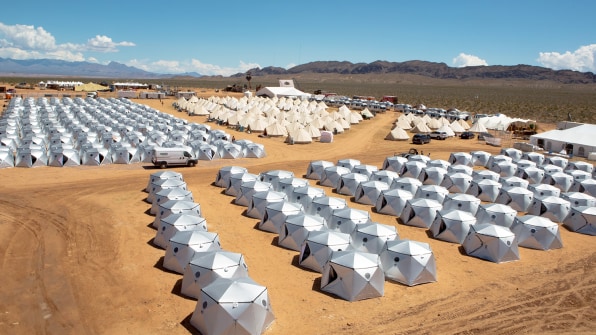
Then the doubts started. He worried about how long it would take to put a hexayurt together, that they’re fragile and hard to store, and that you need a truck to transport them. So Weber, who at the time owned an oil company that deployed an environmentally friendly alternative to fracking, concentrated on planning his camp. He forgot about hexayurts.
Four months later, in the dead of night, he woke up at his home in Napa, California, his brain afire with inspiration. “I couldn’t get the idea out of my head,”Weber tells me during a recent interview. “I started to think about [adapting] the walls of a hexayurt together so they fold up into one piece. I thought about doing it with fabric. I got my origami book out and did some drawings.”
The result was the Shiftpod, a sturdy, insulated, easy-to-construct camping shelter that weighs 64 pounds but transports easily. At 77-by-13-by-13 inches, it’s big enough to fit a queen-sized bed and plenty of gear. Most people can stand up in it.
Originally, Weber planned on making a limited number of Shiftpods for campmates. He told his friends what he was doing and posted an online order form, thinking that maybe 30 people might want one at about $800 a pop. “Someone leaked it on Facebook,” he says. From there, he adds, “people were sending me money, people I didn’t even know . . . that year, we delivered 300 units out to the playa.”
Arriving in the desert that August, in 2015, I saw a Shiftpod for the first time. As someone who, like Weber, had explored countless Burning Man camping methods, I was intrigued by how a Shiftpod could both keep the dust out and be set up in less than five minutes. It looked like a lunar habitat–conversation piece!–and you didn’t freeze overnight. There’s nothing else like it. So prior to Burning Man 2016, I bought one.
In my camp alone last year, there were five Shiftpods and more than 1,000 on the playa. By then, Weber had sold his green-fracking operation and launched Advanced Shelter Systems Inc. (ASSI),the Napa-based company that’s turned his late-night Burning Man lodging idea into a multimillion-dollar business whose market extends far beyond the U.S. festival circuit—so far, in fact, that it requires an entirely new currency.
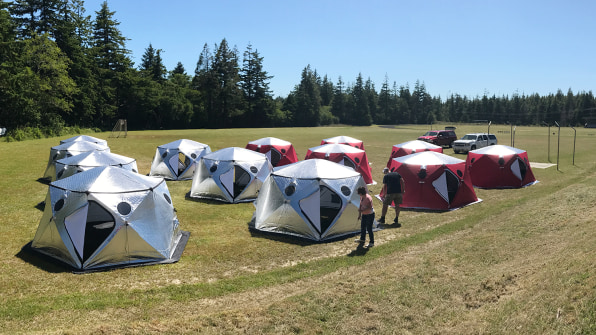
FROM FESTIVAL HUT TO RESCUE SHELTER
Napa is most famous for being one of the world’s great wine-growing regions. Yet even a place dominated by miles of stunningly beautiful wineries has its share of nondescript office parks. And on a recent summer morning, I’m sitting in one with Weber to hear about everything that’s happened with Shiftpods over the last couple of years.
Although the shelters were built with Burning Man’s uncompromising conditions in mind, Weber told me that Burning man attendees, or “Burners,” now make up less than half of his customers. Attendees of other festivals have become dedicated buyers, as evidenced by a photo on the wall of a couple hundred Shiftpods set up at Further Future, an elite music and lifestyle event that the Wall Street Journal says should definitely not be called“Burning Man for billionaires.”
Originally sold for $800, Shiftpods have now progressed to a 2.0 model, and are currently available on sale for $1,299, down from their full price of $1,499. ASSI has also introduced a Shiftpod Mini (“A 110-pound [woman] can put that over her shoulder, hike that into a festival, take it on a plane,” Weber says) and a tunnel system that links two Shiftpods together.
But Weber’s story doesn’t end with the sale of thousands of high-end tents to festival goers. He remembers that when he returned home from Burning Man 2015, a fire was raging in Northern California that eventually killed four people, destroyed more than 2,000 buildings in several towns, and displaced thousands.
“I got back in my car and drove back to Burning Man [and] retrieved 20 Shiftpods . . . from storage,” he said. “We washed them, cleaned them, and rehabbed them” with the intent of donating them to the NGO that was coordinating relief efforts.
But he was rebuffed–the NGO only wanted money. Eventually, Weber donated a few Shiftpods to individual families, but the experience gave him a quick education in the realities of bureaucracy and process on the ground after disasters.
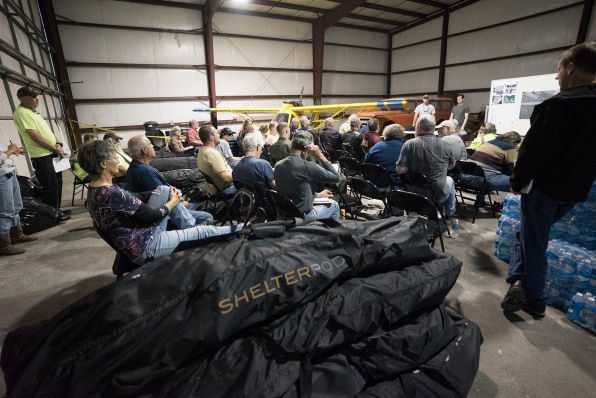
A PLACE FOR THE DISPLACED
From the beginning, ASSI had committed to giving away one Shiftpod for every 20 it sold. But now, Weber was inspired by a larger need for shelters for disaster and emergency management. “There’s 53.4 million forcibly displaced in the world right now because of wars and politics,” Weber says. “A lot of them are living in shanty shacks with blue tarps, so we’re trying to create a low-cost, easy-to-ship, easy-to-set-up unit that people can live in for up to five years.”
You can find ASSI shelters all around the world. They’re in Haiti, Japan, and Nepal. In Greece, they’ve been used to warm up refugees as soon as they emerge from the ocean. Weber says ASSI worked with a software company to donate 200 Shiftpods to the city of Honolulu for disaster response and to help house the homeless in the Nation of Hawaii. And last year, when a hurricane was bearing down on Florida, Weber got a call asking for a thousand units. “We had a few hundred,” he says. “We put them on a trailer and were ready to go.”
This past June, 40 local, state, and federal agencies got together in Cape Blanco, Oregon, for Operation Triton 32, an emergency management exercise geared toward training the military, police, and other local first responders in this remote area to prepare for what could someday be a catastrophic earthquake.
“We were pretty impressed as a whole,” says Jordan Fanning, the emergency operations center coordinator for the town of Brookings, Oregon. “Our first experience was meeting at the airport, and we hadn’t planned for [rain]. It was going to be an outdoor meeting. All of a sudden, there was a downpour. We had a Shiftpod. We ended up using it as our makeshift meeting room.”
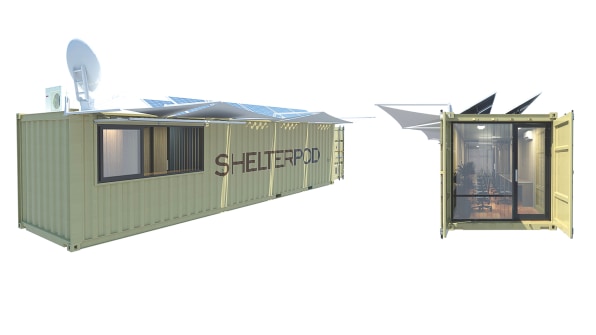
But what everyone involved in the exercise really liked was how easy it was to set up the Shiftpods, Shelterpods, and Responsepods, especially for volunteers with no experience. “That’s really nice, when people can just figure it out on their own,” Fanning says. “You can’t really do that with a lot of the [bigger] shelter companies. There’s lots and lots of pieces, and you have to fit them together.”
Even better, folks from a couple of the Air Force agencies that were on hand appreciated the pods because they could be quickly set up after being flown in on helicopters. “When the Chinook landed,” Weber says, “we could set up a unit before the rotor blades even stopped turning.”
And Shiftpods are sturdy: The force of the rotors never blew any of them down. (In a test at John Brown University in April, one of the shelters was put in front of a giant fan and subjected to increasingly strong winds. Only when gusts hit 109 miles an hour did the pod break loose and go flying.)
Fanning says the city of Brookings is considering buying several dozen Shiftpods as a way to ensure that essential employees have shelter in the event of a major quake. “If we could stick 40 to 50 of these in [a shipping container],” he says, “then we have the ability to respond to the incident [quickly] without having to wait for FEMA or the state.”
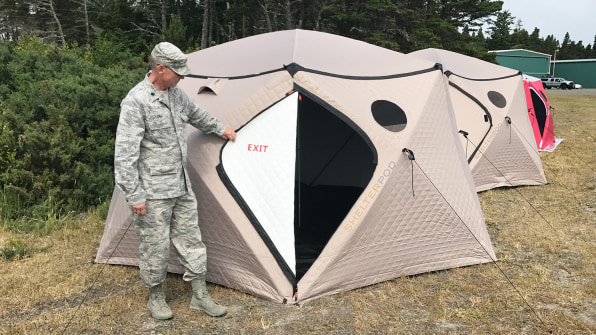
As Weber sees it, one of the biggest challenges in disaster response is that many of the organizations that spring into action end up competing with each other for resources. The result, he says, can be long delays before supplies arrive and hoards of people being forced to hole up in sports arenas, schools, or other big buildings with nothing more than blankets and whatever else they could grab from their homes in a hurry.
He wants to find a solution for that. “Our goal is to set up kits for individuals to take with them that have a shelter, water filtration, and everything you need for a family of four to survive for 30 days,” Weber says. “And to build systems for up to 1,600 people [that can be stored] in one container.”
An obvious customer would be large companies in earthquake zones (like Silicon Valley) that have big parking lots and plenty of space to both store and set up emergency shelters. “You could literally walk out the door, pop open the [container] doors, and set up camp,” Weber says. “All the systems—radio, satellite communications—spool up, turn on, and you’ve got a disaster camp in a box.”
He calls this the Shelterpod Disaster Camp, and you can draw a straight line between it and his Burning Man camp. The kits, Weber says, are “basically our 40-foot shipping container that we use at Burning Man.And every year we unload our camp out of the container and use our container as our kitchen. It literally has fold-down tables [and] air conditioning . . . and when we’re all done, we throw it back in the container, and it’s ready to go for next year.” ASSI would lease the kits to companies or agencies, or donate them to organizations that need them when disasters strike.
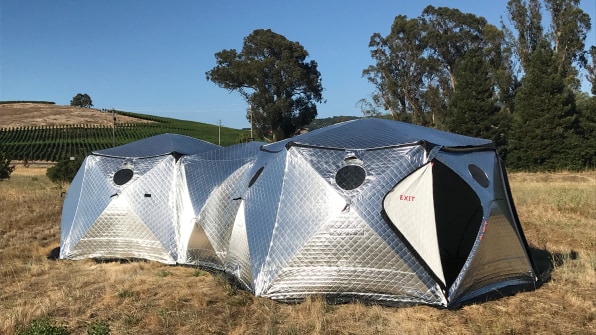
SHELTERCOIN
While ASSI is willing to eat some of the costs of its donations, it’s still a for-profit business with a bottom line. That’s why, in searching for ways to help subsidize costs, the company created an all-new cryptocurrency.
Meant to be launched in the coming weeks, ASSI’s Sheltercoinwill be modeled after Bitcoin and similar systems. If enough value can be vested in Sheltercoin, ASSI would be able to recoup a lot of the donated funds, even as it helps streamline the process for putting money into the hands of those on the ground in disaster areas.
To start, ASSI will hold what’s known as an initial coin offering, or ICO, in which people will buy Sheltercoin with dollars. In conjunction, the company plans to offer Shiftpod customers “steep discounts” if they buy with Sheltercoin instead of dollars.
If a significant number of people buy Shiftpods with the cryptocurrency, Weber hopes, that will prop up Sheltercoin, and ideally raise the currency’s value. The more the value increases, he reasons, the lower ASSI’s true costs on the Shiftpods it donates. “The more people use the coin, the higher the value of the coin, because there’s a limited quantity,” Weber says. “The higher the value, the more equipment we can purchase, the more people we can train, and the more product we can have ready to ship.”
At the same time, Weber hopes to be able to use Sheltercoin as a way to put money in the hands of relief workers who would otherwise have to wait days, or even a week or more, to receive funds sent through traditional methods. “With blockchain [the technology underlying the cryptocurrency], I can send it right to somebody’s phone,”Weber says. “And they can take it to a local company that takes bitcoin for cash and transfer the funds to them in exchange for the local currency.”
Currency exchangers, he adds, are often some of the first people to arrive in emergency situations.
Will it work? Weber thinks so, arguing that Sheltercoin could be the first cryptocurrency backed by a solid company with a global mission and an actual product. He believes a lot of new cryptocurrencies are nothing more than an idea or concept. “We are a well-established company with a hot product going into a huge market,” he said. “So we should be able to create a lot of demand for the coin.”
Heather Vescent, a futurist and expert in alternative currencies, agrees that the thirst for cryptocurrencies these days is “ridiculous.”
Vescent, who doesn’t have any firsthand knowledge of ASSI’s plans, lauds the company’s strategy for building a cryptocurrency around its social values. But she cautioned that ASSI and those using Sheltercoin would have to be disciplined and not allow the coin to be used in ways that are counter to those values.
And while she noted that there’s plenty of potential for a new coin to have huge gains, volatility in the cryptocurrency market could very easily lead to big losses for Sheltercoin’s backers.
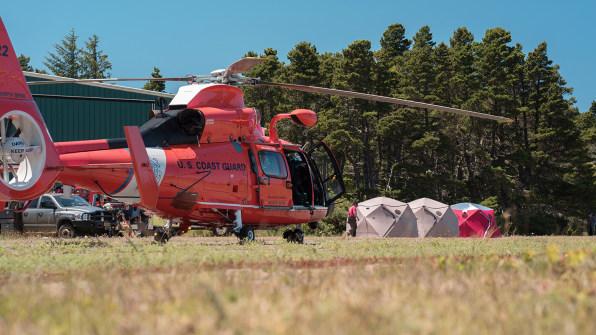
Weber is aware of the risks and is ready to shoulder losses should Sheltercoin collapse. But he’s convinced it’s the best way to propel ASSI’s mission of getting the company’s shelters where they need to be–and in turn, helping as many people as possible.
As for when he will launch the ICO, he says he’d initially kicked around the idea of doing it the same night that the Man (Burning Man’s namesake effigy) burns.The festival, and its community, he says, are “our roots, so we’re not going to forget where we came from.”
“I always thought going to Burning Man was my release and my hobby,” Weber continues. “Now I’m able to take a lot of stuff I’ve learned out there and turn it into a product I can share with the world, and help a lot of people not only have fun, but who need help and shelter.”
https://journal.burningman.org/2020/09/news/official-announcements/save-black-rock-city/
Let’s break this one down, misleading statement after misleading statement, sound good?
“With the cancellation of Black Rock City 2020 due to the COVID-10 pandemic, Burning Man Project lost 90% of its annual revenue. We are now faced with the reality of running a global nonprofit without our primary source of revenue. While we’ve cut our costs dramatically, we are at risk of running out of money in December, and we will not be able to bring back Black Rock City unless we have the support of our community.”
Certainly, this is true. Obviously without ticket sales beyond donations, that’s going to take a big cut out of the $46,641,655 in revenue that they generated as noted in their 2018 filings.
Also of note is $26,256,356 in net assets,which, considering that they were listing $19.9M in assets in 2016, is a significant jump, only leading me to believe that they certainly had some more assets to report in their 2019 filings. (in time for the Google purchase or after?)
But since I can’t seem to track down every piece of these net assetsand I certainly don’t want to be embroiled in a lawsuit for doing something crazy like, I don’t know, filing a Freedom of Information Act request (https://www.rgj.com/story/life/arts/burning-man/2020/04/29/burning-man-sues-blm-prevent-release-financial-records/3050608001/) I’ll just, as usual, have to go on their word and hope they’re not gaslighting all of us. After all, lawsuits are extremely expensive, I wouldn’t want to waste what little money that Burning Man Project has left on suing little old me for asking them to be transparent.
“Thanks to carefully setting aside incremental savings over the course of eight years, by the end of February, 2020 Burning Man Project had approximately $10 million in our operating reserve, kept aside to manage contingencies like this one.”
https://journal.burningman.org/2020/04/news/global-news/2020-financials/
Well, great! Contingency managed right?
Oh, woop, SORRY NOPE.
“It’s going to take each one of us contributing what we can to SAVE BLACK ROCK CITY. Our goal is to raise $1,500,000 by the end of October to help Black Rock City survive.”
This remains in spite of the fact that, as per their “big picture” site they have slashed costs in these ways:
Budget Reductions 51% Cut – $24M
Operating Reserve Used – $10M
Federal PPP Loan Received – $2.7M
2020 BRC Ticket Sale Donations – $3M
Annual Fund & Major Gifts Thus Far – $3M
https://donate.burningman.org/big-picture/
Adding that all up before the $1.5M that they “need” to survive, this amounts to cutting out $32.7M out of their expenditures, which, including the $10M contingency fund, amounts to $42.7M
When considering that their 2018 filings show that their total expenses amounted to $44,041,808It then becomes incredibly clear where this $1.5M is going. It’s being used to cover the shortfall between their typical expenses in a year where, ya know, THERE WAS ACTUALLY AN EVENT.
This becomes even more disgusting when considering a couple of details that they left out of these extremely vague finances that are supposed to unveil the “big picture” of the finances of Burning Man Project, in particular this little nugget from one of their previous posts.
“We’re not just looking to the community for support. We’re also talking to the government. We’re asking the Bureau of Land Management (BLM) to refund approximately $1.9 million in payments we’ve already made for the 2020 event. It will require a long process, but we expect to be refunded most of it.“
While we’ve been left out of this conversation so it’s tough to say whether they met expectations on this (which if they didn’t, what exactly are their $16,715,283 in salaries going to again?) but this alone covers what they are missing in revenue and then some.
Maybe the idea is that with the donations they can re-bolster their staff and roll back their budget cuts. But to this I say, why? We have yet to be given a tangible list of what was actually cut from the budget and how this impacts the actual operation of Black Rock City.
But perhaps, this is really where the $1.5M is going:
-
Marian Goodell, CEO: $261,000
-
Larry Harvey, President: $211,000
-
Theresa Duncan, Director of philanthropic engagement: $187,000
-
Harley K. Dubois, Director: $176,000
-
Ray Allen, General counsel: $174,000
-
Doug Robertson, Director of finance: $161,000
-
Heather White, managing director: $160,000
-
Kim Cook, Director of art and civic engagement: $156,000
-
Charlie Dolman, event operations director: $151,000
-
Crimson Rose, secretary: $145,000
Obviously, with Larry gone, these numbers are actually from their 2017 filings. What their 2018 filings will show is that some annual raises exceeded $40,000.Even just assuming that was one salary and removing Larry’s salary as President, we still are looking at $1.425M in salaries for 9 people which puts each of them within the top 5% of income in the country.
How radically self-reliant of them to indulge themselves in our hard-earned money for jobs completely necessary to the operation of Burning Man Project such as “Director of philanthropic engagement,” “Director” and “Managing Director.” I leave out “General Counsel” of course because how else would they be able to sue someone for asking questions? Black Rock City wouldn’t be the same without that.
But your donations certainly aren’t going into their pockets (after all, they’re collecting their salaries no matter what, that’s what the $10M contingency fund is for after all). They’re going to these really important causes
“Here’s what we’re doing with your contributions:
-
Retention of critical staff who are working hard to bring Black Rock City back, more inclusive and more sustainable than ever before.
-
Maintenance of key infrastructure, especially our heavy equipment, needed to produce the event and support artists and art projects.
-
Supporting our critical work with the Bureau of Land Management and other government agency partners on permitting, event operations, stewardship, and more.
-
Ensuring the health and safety for our city, including consulting with epidemiologists, virologists, and medical practitioners to stay in front of best practices to help us gather safely in this new reality.”
For starters, as noted previously, they applied for and received funds from the Paycheck Protection Program. There was not an event this year so while I’m sure there are maintenance costs, I can’t reasonably believe they are as high as usual. They already stated that they were likely to receive a refund from BLM. And the last part is just something they really wanted to get in there to make you understand how seriously they’re taking the pandemic while planning a 70,000 person event. I look forward to the itemized list of expenses for “consultations.”
And, as infuriating as breaking down these finances are, on a personal note, I’m just kind of insulted at the insinuation that what they do is what makes Black Rock City happen,not what we all do together as a community. By conflating the ideas of donating to them with saving BRC, they are essentially casting themselves as the only potential purveyors of the community of Burning Man. They are saying that if their organization goes under due to operating costs, again, an extremely laughable scenario when the amount of money they’re asking for covers 9 people’s salaries, the other 70,000 of us with our $42M in ticket money could not possibly put together such an event.Last I heard, there was no copyright on meeting together in a desert, but that’s apparently what they think we can be led to believe.
So, to be clear, the $1.5M they’re asking for in their post is not only largely inconsequential in the scheme of the finances (it represents 3% of their expenses in a year in which they actually have Black Rock City) but has absolutely zero bearing on whether we can have Black Rock City or not, and I find it completely against the principles of the event to withhold BRC if their demands aren’t met.
And if they were truly serious about being transparent, we’d have an accounting of how much money they saved by not having the event this year,not just how much they didn’t get in revenue.
tl;dr, the already $6M dollars they’ve collected from donated ticket sales and gifts are already far too much. With budgetary cuts, contingency funds, and the Paycheck Protection Program, they already have $42.7M taken care of in their usual ~$44M in expenses for a year in which Burning Man actually happened. Add in the $1.9M they expect in a refund from BLM, they’ve actually already exceeded this total, raising questions as to whether rolling back budgetary cuts would enable their top 9 salaries to continue to exceed $1.425M. With their established behavior of suing those who submit Freedom of Information Act requests to them and their refusal to itemize their expenditures for the public, it becomes apparent that they are unwilling to explain how they spent so much money in a year without an event. It is a bold-faced lie that Black Rock City would be in danger if they don’t receive the $1.5M they are demanding by the end of October as there is zero explanation as to why Black Rock City can’t happen if they don’t continue to operate on items completely unrelated to Black Rock City.
Super tl;dr DO NOT GIVE THEM YOUR FUCKING MONEY
But, if you have the extra cash and really want it to go somewhere good, here are some actual non-profits you can donate to that will impact the world in the way that the ethos of Burning Man promises but Burning Man Project isn’t delivering on:
https://ywcaisjustice.org/donate/
https://www.malariaconsortium.org/
These were a few I managed to research and find at least threads of ethical behavior that would lead me to believe they are good charities to donate to. But I also always recommend everyone to do their own research and feel free to mention any other charities you think need help, are transparent, great and represent the ethos of our community!
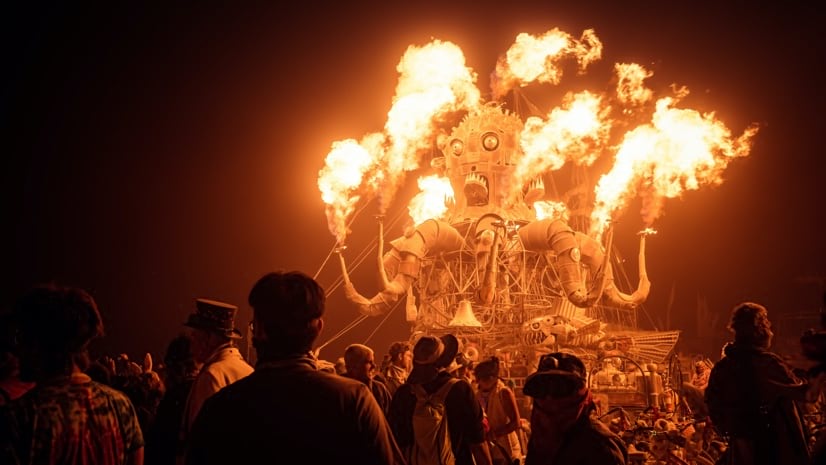
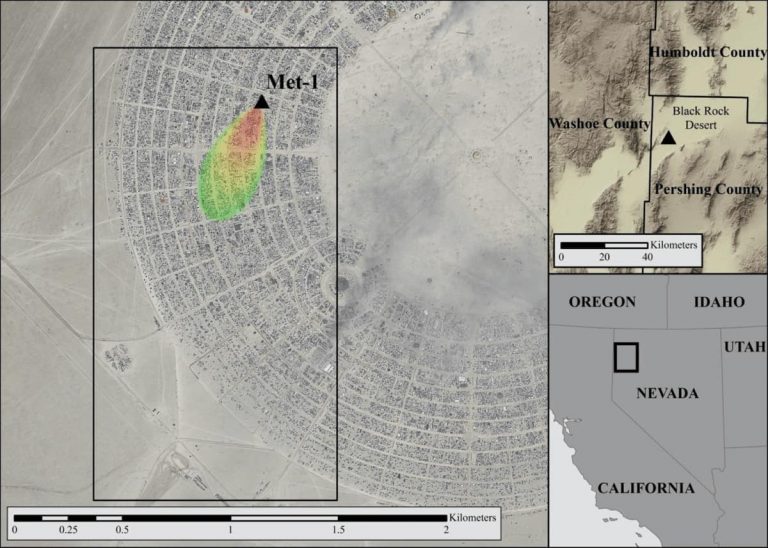
Attracting free-spirited exploration of new age ideas in a temporary city setting, the iconic annual Burning Man festival purports to be a “crucible of creativity . . . dedicated to community, art, self-expression, and self-reliance.” Now, scientific discovery can be added to the list.
The in-person gathering won’t occur this year due to the coronavirus pandemic, but data from a past year’s gathering is proving useful to climate change researchers. The atmospheric effect of the pop-up city created to accommodate more than 70,000 attendees suddenly occupying an otherwise uninhabited space in Nevada’s Black Rock Desert helps scientists understand yet another human impact on climate.
“Normally when we study the microclimate of cities, it is difficult to assess what the landscape would be like if the city were not there, or if the city was significantly different,” said Andrew Oliphant, a micrometeorologist and chair of the Department of Geography & Environment at San Francisco State University. “Black Rock City gave us the opportunity to do that analysis.”
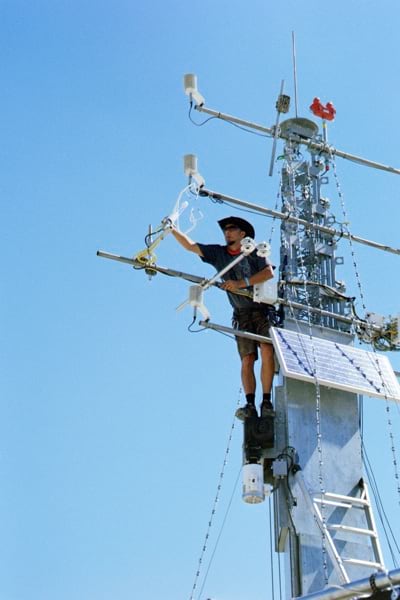
Investigating BRC’s Evolution
Evolving from annual bonfire gatherings on San Francisco’s Baker Beach in the 1980s, Burning Man moved in 1990 to the Black Rock Desert of Nevada for more space. At its start, the festival took place in June for the summer solstice. Now, it marks the end of summer.
Attendees set up a temporary metropolis, Black Rock City (BRC), to participate in community and civic life and connect with nature. The site’s flat, arid, vegetation-free playa also proved perfect for climate research.
“The frictional properties of the surface are extremely small prior to the construction of the city, and there are no sources or sinks of carbon dioxide (CO2) from vegetation, no transpiration, and very little evaporation from the dry lakebed sediment,” Oliphant said.
With so little impact to the atmosphere before people arrive, Oliphant and his research team could accurately measure the impacts of human activity. They investigated the changing micrometeorological impact of BRC by measuring surface energy and CO2 emissions. They measured surface roughness using wind speed profiles and three-dimensional sonic anemometers. Then, they modeled the roughness in a geographic information system (GIS).
“Wind speed profiles were used to determine the changing surface roughness and validate the GIS modeling,” Oliphant said. “The surface energy balance was measured to determine the impacts of the built city on surface heat fluxes, and temperature measurements were made to determine the urban heat island status.Surface-atmosphere CO2 fluxes were measured to determine urban carbon emissions.”
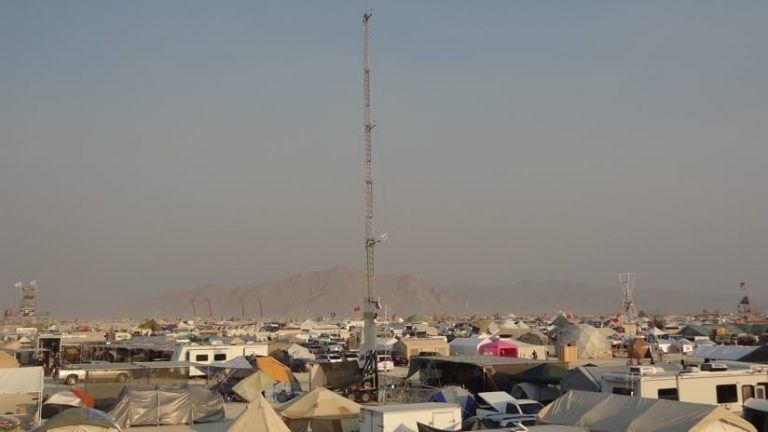
Sensor Towers on Site
For this project, Oliphant and his research team used the 30-meter-tall mobile micrometeorological tower called the California State University-Mobile Atmospheric Profiling System (CSU-MAPS). The tower is equipped with wind speed, temperature, and radiation sensors. It also has an eddy covariance system that uses a high-frequency gas analyzer and a three-dimensional sonic anemometer to determine fluxes of CO2, water vapor, and heat on the surface and in the atmosphere.
With all the flames, explosions, lasers and lightshows going on, how much of the CO2 fluctuations were due to those?
The tower went up prior to the start of the 2013 festival, and the team made measurements throughout the event. A smaller, similarly equipped tower was deployed outside of the city in the open playa to provide baseline measurements. Researchers took turns riding an instrumented bicycle around the area to regularly measure temperature profiles.
The team took measurements for 12 days—before people arrived, during construction and throughout the event, and after the event concluded. The Burning Man organization provided data about attendees, including a census report detailing population changes, as well as transportation and energy consumption surveys.
“We determined that wind speed was reduced after the construction of the city, particularly below five meters,” Oliphant said. “However, surface radiation and energy fluxes were little changed after the development of the city.”
The team did not detect a heat island effect, which normally takes place in cities because surfaces such as concrete and asphalt capture the sun’s heat during the day and release it at night. Because there were no such surfaces to absorb the sun’s heat in BRC, there was no subsequent additional release of heat at night.
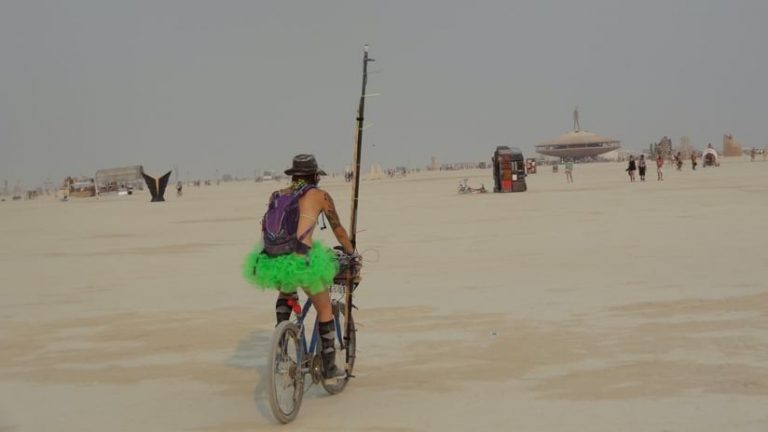
Interestingly, the amount of carbon dioxide from the breath of attendees far exceeded emissions from transportation, which won’t be true of any other city. However, these findings will help inform environmental impact assessments for other geographies and gatherings.
Because BRC’s urban design and building elements are similar to those found in other informal settlements—such as refugee camps, shanty towns, or favelas—the finding can support research in those areas. Oliphant said, “Our results will help refine weather forecast models and air pollution transport models applied to these temporary urban environments.”
Learn how GIS keeps track of weather and climate to inform forecasts, preparedness and adaptatio
Micrometeorology of an ephemeral desert city, the Burning Man experiment
Computer Science > Social and Information Networks
The “small world phenomenon,” popularized by Stanley Milgram, suggests that individuals from across a social network are connected via a short path of mutual friends and can leverage their local social information to efficiently traverse that network. Existing social search experiments are plagued by high rates of attrition, which prohibit comprehensive study of social search. We investigate this by conducting a small world experiment at Burning Man, an event located in the Black Rock Desert of Nevada, USA, known its unique social systems and community participation. We design location-tracking vessels that we routed through Burning Man towards the goal of finding a particular person.Along the way, the vessels logged individual information and GPS data.Two of fifteen vessels made it to their designated people, but a month after Burning Man. Our results suggest possible improvements to limit rates of attrition through community participation and a design methodology that emphasizes cultural practices to aid social experimentation.
Submission history
From: Ziv Epstein [view email]
[v1] Mon, 11 Mar 2019 04:55:17 UTC (3,787 KB)
Jessica McCaffrey, Concordia University
Introduction
Chapter 1 – Research in Wonderland
Chapter 2 – Research Methods
Chapter 3 – Finding the Neo-Tribe
Chapter 4 – Sensing and Enacting Alternatives
Chapter 5 – Transforming Community
Chapter 6 – Community as Social Movement
Conclusion
* This work is a revised version of the thesis presented in partial fulfillment of the requirements for the Degree of Master of Arts (Social and Cultural Anthropology) in the Department of Sociology and Anthropology, Concordia University, Montreal in September 2012.The supervisory committee consisted of Mark Watson (Principal Supervisor), Christine Jourdan, and David Howes.

| Figure 1: The Man effigy, 2010Photograph by author. | Figure 2: The Man effigy (2010) surrounded by art cars. Photograph by author. |
Introduction
This work will explore the countercultural event know as Burning Man through the stories of Montreal participants. Burning Man is arguably the “freak epicentre” (St John 2009b:52) of North America’s countercultural artistic movements; since its inception in 1986, it has grown from a few dozen friends sitting around a fire in a San Francisco nature reserve, to over fifty-thousand people converging in the middle of Black Rock Desert, Nevada to build a temporary city, live in it for a week, and then pack up leaving without a trace. During the festival the city is a topsy-turvy Wonderland of artistic projects and performances which clearly invert the norms of everyday life. Burning Man has been described by both participants (hereafter Burners[1]) and scholars as a ritual process (Gilmore 2005 and 2008, Hockett 2004, St John 2008). It is one contemporary countercultural ritual where the latent aspects of everyday life can be performed, contested, re-imagined, or reaffirmed in extraordinary ways. Much of the research on Burning Man has focused on liminal experiences and communitas during the festival. Liminality, or the redressive phase of the ritual process, is marked by “the release from mundane structures, the movement […] from center to periphery, participant ordeals, [and] a homogenization of status” (St John 2008). During this phase a sense of communitas is fostered. Communitas “is a meeting point, or interface between individuals in a direct, immediate and total confrontation of human identities. It is a brief moment of deep human connection, a spontaneous event, a flash of unity” (Hockett 2004:198).
The ritual process, as the anthropologist Victor Turner famously described, includes three phases: separation, liminality, and reaggregation (Turner 1969). I have decided to examine Burning Man using these three categories of experience. In doing so, I am following the work of several previous researchers (Gilmore 2005b and 2008, Hockett 2004, St. John 2009). However, what makes my approach distinct is the focus I draw to the ‘before and after’ of the ritual itself; that is the phases of separation and reaggreation. My primary concern is with how the Burning Man experience interacts with participants’ lives in Montreal. As Burning Man has been described to me as “a spiritual experience” and an “awakening” I would like to know what happens after the festival considering so many participants feel their lives are profoundly changed by the experience. Also, I would like to ask how do individuals begin this ritual process in the first place? Where does it start?
Personal narratives provide an interesting way to explore the ritual process as they allow the researcher greater insight into the personal and particular trajectories of collaborators. “[The] everyday lifeworld is a world of discourse, language games, and communicative activity. In Habermas’s conception of the lifeworld, narrative plays a singularly important role, for narrative makes it possible for people to create coherent scenarios which articulate shared meanings” (Jackson 1996:38). Since the ritual process is thought to move through three stages, narratives are one method for following the process of ritual experience beyond the limits of the festival and into participant’s everyday life. My research is therefore centered on the Burning Man narratives of my collaborators in Montreal.
The interviews I have conducted with collaborators have highlighted the ritual process as part of a larger trend in countercultural practices concerned with the reenactment and recreation of temporary autonomous zones, or TAZ (Bey 1985).
Bey advocates something that he calls ‘immediatism’, indicating an ‘antagonism to all forms of mediated, passivity-inducing leisure and culture’ and a ‘festal culture’ based on hedonistic spirituality and tribalism working against the familial arrangements of conventional society. […] The TAZ is an advance glimpse of utopia… a microcosm of that ‘anarchist dream’ of a free culture, but its success depends on its impermanence
(Fortunati 2005:154).
Many (but not all) of my collaborators have indicated that before and after their Burning Man experience(s) they have participated in satellite and sister events which promote similar immediate and participatory, intensely sensory experiences. Burning Man has all the elements of a ritual process, however, this ritual is not one which socializes individuals into the dominant sociocultural paradigm. Rather, through the ten principles of Burning Man (which I will list below), the event inspires participants to take the alternative language, socio-sensual practices and values which they co-create in the context of Burning Man and incorporate them into their everyday life. In this sense the ritual process feeds countercultural moral practices inspired by TAZs and fosters a sense of community among participants.
spacer
Annals of Tourism Research
Designing experiences in the age of human transformation: An analysis of Burning Man
Abstract
In the emerging transformation age, not only do experiences with transformational qualities happen by chance, but they are induced through intentional design. This study investigates the human gathering Burning Man, often stipulated as one of the world’s most transformative large-scale experiences. Grounded in the theoretical lens of environmental psychology, a deep topological analysis was conducted based on Instagram data to analyse participants’ digital outer expressions and find answers to their innermost transformative experiences. Through a holistic analysis of the pre-liminal, on-site, and post-liminal stages, socio-environmental and socio-psychological spheres, with 30 clusters that trigger potential transformation, could be revealed. This study contributes to the interdisciplinary discourse relating to human experience and transformation design in the tourism, events, and experience sectors.
Recent studies have started to decipher transformational festivals as a time-space setting that holds a unique combination of intentional design, social environment, and ambience for creating human growth/flourishing (Neuhofer et al., 2020) and triggering behavioural interactions within and beyond that particular space (Rowen, 2020).Transformational festivals originate from North America, referring to counterculture gatherings where the goal is to immerse attendees into an interactive and thought-provoking liminal space through spiritual practices, music, and psychedelic entertainment, among many others, and to alter one’s ingrained beliefs and thoughts (Johner, 2015). In tourism, the newly born concept of transformational festivals can be seen as a temporary attraction that involves a wider social movement both online and offline (Rowen, 2020). By drawing upon the wider disciplines of humanistic, positive, and environmental psychology, recent studies have proven that human transformation is connected to self-actualisation, self-transcendence, positive emotions, and awe-inducing moments (Wang & Lyu, 2019; Yaden et al., 2019) as well as contextual and liminal factors that give rise to a potential expansion of the self (Pung et al., 2020; Wu, Li, Wood, Senaux, & Dai, 2020). The interconnectedness of a human experience and its contextual environment is critical for a deeper understanding of how transformation unfolds.

FLY RANCH: AN OPEN-SOURCE BURNING MAN PROJECT | ONLINE
About this event
In 2016, Burning Man Project acquired Fly Ranch. The 3,800 acre parcel in northern Nevada is home to dozens of hot and cold pools, three geysers, wetlands, a playa, an old farmhouse, dozens of animal species, and more than 100 identified types of plants. Learn more here: https://flyranch.burningman.org/.
Fly Ranch can serve as an incubator for the Burning Man community to take ideas and give them a real-world testing ground. It can become a place to experiment with shelter, energy, water, environmentalism, new models of living, working and governance.
Burning Man is using an open-source approach and software to plan and coordinate. In this talk, we’ll discuss our property, approach, resources, and challenges.
If you missed it, you can see the talk here: https://www.facebook.com/generalassemblysf/videos/763600273836684/, and slides here: http://slides.com/mateosanch/deck-2-5.”





| PYR– before vowels pyr-, word-forming element form meaning “fire,” from Greek pyr (genitive pyros) “fire, funeral fire,” also symbolic of terrible things, rages, “rarely as an image of warmth and comfort” [Liddell & Scott], from PIE root *paewr- “fire.” Pyriphlegethon, literally “fire-blazing,” was one of the rivers of Hell |
|
-sis | Meaning of suffix -sis by etymonlineOnline Etymology Dictionary
suffix in Greek-derived nouns denoting action, process, state, condition, from Greek -sis, which is identical in meaning with Latin -entia, English -ing (1
|
spacerLearn about the pyrg
 spacer
spacerIsn’t it bizarre how the tri-op shrimp resembles the land configuration in the above photo? The photo was found on the Fly Ranch Website and is a picture of the landscape in the area.


Three-Eyed “Dinosaur Shrimp” Are Waking Up At Burning Man
<hass=”article__header__summary summary”>The human festival is over, but for Triops and fairy shrimp, it’s just getting started.

Triops like T. longicaudatus reach adulthood around eight days after hatching.
Image credit: ursusarctoshorribilis via iNaturalist, CC BY-ND 4.0, cropped
Epic floods have hit Black Rock City in the Nevada Desert, hitting festivalgoers at Burning Man, one of the world’s most famous artistic events. While some fled on foot, others sat back and enjoyed the unique self-sufficiency Burning Man is built on, but they will be joined by a host of bizarre organisms that can lie dormant in the dried-out lake bed for decades.
Triops and fairy shrimp are extremophiles capable of surviving years-long droughts. They endure in the sediment as eggs that remain dormant until floods bring about the right conditions for them to do some topside living.
Relatives of the oldest living creature, Triops cancriformis, are among the fold, which is why Triops have the nickname “dinosaur shrimp”. These “three-eyed” miniature beasties have two main eyes and a pit organ, a “third eye” that’s common among insects, and comes in handy for prey animals as it enables them to detect changes in light– be that a bird coming in to hunt, or the muddy boots of Chris Rock escaping a flooded art festival.
They are joined by fairy shrimp, characters you might be more familiar with under the name sea monkeys. Fairy shrimp (Branchiopoda) are translucent crustaceans found in vernal pools and hypersaline lakes across the world. The diddy little shrimp are sometimes called brine shrimp as – being extremophiles – they’re exceptionally good at tolerating salty environments.
The arrival of these desiccated crustaceans on the Black Rock playa lakebed isn’t abnormal, and won’t be a surprise to return visitors to Burning Man. As the Bureau of Land Management (BLM) explained on Flickr, Friends Of Nevada Wilderness (FNW), a partner organization that supports the BLM’s Winnemucca District, attends the festival to spread the good word of dinosaur and fairy shrimp.
It’ll take just over a week for some of these critters to start making eggs of their own, but the race is on if the weather takes a turn. As these “modern fossils” retrieved from the Black Rock Desert demonstrate, any crustaceans caught wandering the sediment when it dries won’t fare as well as their eggs.

Godspeed, you crazy crustaceans.
spacer
Living Fossils in the Arizona Desert/Dinosaur Shrimp
Triops have enduring eggs
Triops have a short and relatively simple life cycle. They start as tiny eggs that can survive long periods of drought. The eggs can last up to 27 years, after which they can still hatch if exposed to water.
When these eggs get wet, they hatch into small nymphs. These nymphs grow rapidly, reproducing quickly, and typically only live for a few months. This short life cycle is one of the reasons they can thrive in temporary aquatic habitats.
Under the right conditions, these animals can suddenly hatch in large numbers, which is exactly what happened at the Burning Man, where temporary water pools were suddenly formed in typically arid conditions.
spacer
Hundreds of weird three-eyed ‘dinosaur shrimp’ emerge after heavy rain
The miniature pink critters basically look like Pokemon, and evolve from eggs like them, too.

Tourists roaming Wupatki National Monument, an ancestral Puebloan site in Arizona, recently stumbled upon some unlikely fellow visitors — hundreds of pre-dinosaur-era three-eyed shrimp. The little critters presumably infested a ball court at the park after a monsoon filled it to the brim.
Formally named triops, the gentle beasts that roamed Earth hundreds of millions of years ago literally have a third eye.It’s smack in the middle of their two compound buggy ones that peer straight ahead. The creatures, also called tadpole shrimp, are an inch or two long and their peachy pink bodies have a crest-shaped torso that tapers off into a dangly tail.
They’re the epitome of creepy, yet somehow adorable. They basically look like Pokemon.
It’s not uncommon to find a few of these guys in the wild, and some pet stores even sell them, claiming triopses are low-maintenance friends — they only live up to about 90 days. But for tourists to find hundreds of the alien-like creatures at the site of a national monument is definitely… new.
Puebloan farmers fled from from modern-day Flagstaff to the region of Wupatki National Monument following the eruption of Sunset Crater Volcano 900 years ago. Within the area, now protected by the state and open for tourism, there’s a circular ball court that used to be the site where cultural ideas got exchanged. The court measures about 105 feet (32 meters) in diameter.
In late July, however, these whimsical shrimp filled the former intellectual meeting spot. Lauren Carter, lead interpretation ranger at Wupatki National Monument “just scooped it up with [her] hand and looked at it and was like ‘What is that?'” she said in a statement.
Presumably, the triple-eyed shellfish abruptly emerged in the triple digits due to Arizona’s late-July monsoon.These shrimp can lay eggs that remain dormant until enough water is present. A monsoon’s downpour could’ve easily activated a bunch of their already-laid eggs to hatch.
Carter said she first learned of the critters’ presence in the rainwater pond by a tourist wandering the park. Eventually, she and the rest of the staff concluded these strange-looking shrimp could be freshwater versions of triops called triops longicaudatus. They note that further scientific analysis is needed to confirm that hypothesis.
The exceptionally astute organisms — visually, that is — were apparently spotted by birds in the area and promptly turned into an avian dinner. But who’s to say they didn’t lay a few more eggs in their chosen breeding grounds at Wuptaki?
 Wupatki Spirit Totem Wupatki Spirit Totem
A mysterious spirit totem at the edge of Navajo lands.NO ONE SEEMS TO KNOW the origin of the spirit totem nor exactly how long it’s been present on “Deadman Flats” and the edge of Navajo lands. Locals will tell you the totem has been around “a very long time” or “for as long as I remember.” Wupatki National Monument, a place of ancient pueblos, is just east of the totem, as is the Navajo sacred place, Chezzhin Deez’d, Black Point or Black-Rock Point, an ancient basalt lava flow where the founders of the Western Water Clans journeyed eastward from the point of their creation on the shore of the Pacific Ocean, crossed the Little Colorado on their way from the San Francisco Peaks. Travelers often leave gifts and tokens in the totems. Possibly it is for safe travels, maybe it is in respect to the ancients who travelled past years ago. |
WupatkiWorld History Encyclopedia
Sep 24, 2018 — The name “Wupatki” is of Hopi derivation and means “tall house,” which refers to the ruined pueblos formerly occupied in ancient times.
|
| Wupatki, which means “Long Cut House” in the Hopi language, is a multistory pueblo dwelling comprising over 100 rooms and a community room and the northernmost ballcourt ever discovered in North America, creating the largest building site for nearly 50 miles SOURCE |
Prehistory of Wupatki | American Southwest Virtual MuseumNorthern Arizona University
The Navajo name for Wupatki is Anaasází bikin (Ancient People’s Home).
|
Cultural Perspectives – Wupatki National Monument (U.S. …https://www.nps.gov › wupa › learn › historyculture
Feb 24, 2015 — The Hopi call their ancestors Hisatsinom, meaning “People of the past.”
|
Park Archives: Wupatki National MonumentNPS History
Archeologists coined the term Sinagua for the cultural tradition of this area, reflecting the people’s ability to farm and live virtually “without water.”
|
|
UPDATED 29 MARCH, 2016 – 21:48 NATALIA KLIMCZAK
More than 1,500 Petroglyphs, including a Solar Calendar, Found in Northern ArizonaArchaeologists who explored the remote mesas of Northern Arizona have identified a previously undocumented group of petroglyphs, one of which confirms the presence of a prehistoric solar calendar. According to Western Digs , the solar calendar has been marking the seasons for more than 700 years with a shadow dagger that travels across the sandstone face. This feature is made by a natural outcropping of rock above a panel of petroglyphs. Western Digs reports that the “shadow dagger” bisects a spiral carved onto the cliff wall, while another shadow interacts with a set of eight circles pecked into the panel’s left side.” The researchers discovered the petroglyphs in the back country of the Wupatki National Monument site northeast of Flagstaff, in Arizona, USA. The area includes the ruins of dozens of sites built by Ancestral Puebloans, also known as the Kayenta or the Sinagua. Among the petroglyphs, the most eye-catching is the one located on the southern face of a sandstone ledge at Horseshoe Mesa’s northern end. It is known as Panel 50, and was recorded for the first time in 1931. Purcell confirmed that it is an imaging calendar, which means a time-tracking feature that uses the play of light and shadow. The panel is a set of eight circles, each 7 to 9 centimeters (3 to 4 inches) across, arranged in rows of two, three, two, and one.
An example of a Cave painting at Palatki Heritage Site near Sedona, Arizona, USA depicting the position of the sun with respect to the facing rock formations at the various solstices. ( CC BY SA 3.0 ) |
Wupatki National Monuments is the perfect place to walk back in time and see what life was like 900 years ago. You can walk around and inside many of the pueblos that are still standing in the park. Make sure and stick to the trails because the grounds contain fragile archeological sites.
ANCESTRAL PUEBLOANS AND WUPATKIWhile there’s regional evidence of Native Americans in the region dating back 10,000 years to the Clovis people, the primary structures of Wupatki are associated with the Ancestral Puebloans. |
spacer
|
also from early 14c.
|
Google: So big we stopped counting
The AP reports today that the company will no longer list the size of its search index on its home page.
Says the wire: “When Google started the practice in mid-2000, the index spanned 1 billion pages; as of Monday afternoon, Google’s home page said the search index contained 8.17 billion pages.”
Yahoo started making similar claims, except it claimed to index 96 gazillion pages (Ed. – Or something like that), a claim that “came under immediate fire from Google executives,who questioned its accuracy before finally concluding that the two companies are counting things differently.”
Google now says it and Yahoo are “counting things differently” and has agreed to disagree. “And – na na-na na na-na – by the way, we’re so huge we don’t even have to put it on our home page anymore.” That’s more of an artistic interpretation of what we think Google would say than an actual quote, but you get the drift.
Via My Way News
For more information on GOOGLE, check out the following post:
Geoffrey Hinton, who has been called the ‘Godfather of AI,’ confirmed Monday that he left his role at Google last week to speak out about the “dangers” of the technology he helped to develop.
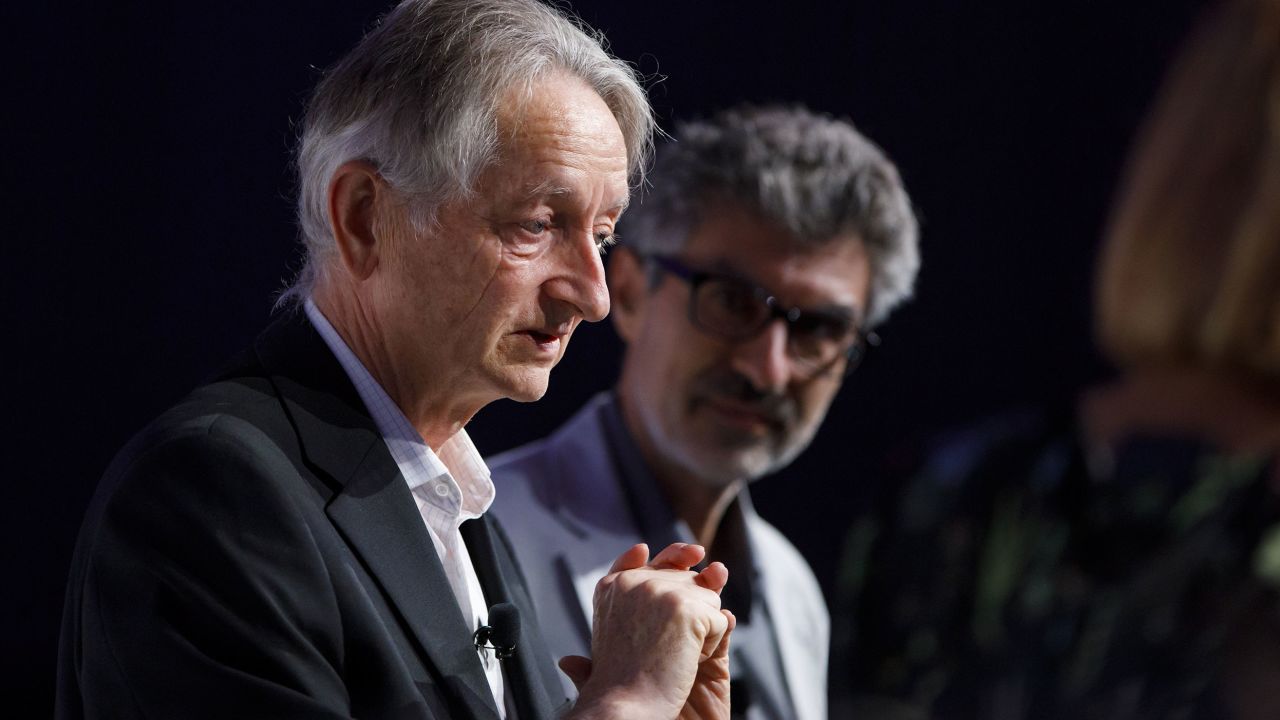
Hinton’s pioneering work on neural networks shaped artificial intelligence systems powering many of today’s products. He worked part-time at Google for a decade on the tech giant’s AI development efforts, but he has since come to have concerns about the technology and his role in advancing it.
“I console myself with the normal excuse: If I hadn’t done it, somebody else would have,” Hinton told the New York Times, which was first to report his decision.
In a tweet Monday, Hinton said he left Google so he could speak freely about the risks of AI,rather than because of a desire to criticize Google specifically.
“I left so that I could talk about the dangers of AI without considering how this impacts Google,” Hinton said in a tweet. “Google has acted very responsibly.”
Jeff Dean, chief scientist at Google, said Hinton “has made foundational breakthroughs in AI” and expressed appreciation for Hinton’s “decade of contributions at Google.”
“We remain committed to a responsible approach to AI,” Dean said in a statement provided to CNN. “We’re continually learning to understand emerging risks while also innovating boldly.”
Hinton’s decision to step back from the company and speak out on the technology comes as a growing number of lawmakers, advocacy groups and tech insiders have raised alarmsabout the potential for a new crop of AI-powered chatbots to spread misinformation and displace jobs.
The wave of attention around ChatGPT late last year helped renew an arms race among tech companies to develop and deploy similar AI tools in their products.OpenAI, Microsoft and Google are at the forefront of this trend, but IBM, Amazon, Baidu and Tencent are working on similar technologies.
In March, some prominent figures in tech signed a letter calling for artificial intelligence labs to stop the training of the most powerful AI systems for at least six months, citing “profound risks to society and humanity.”The letter,publishedby the Future of Life Institute, a nonprofit backed by Elon Musk,came just two weeks after OpenAIannouncedGPT-4,an even more powerful version of the technology that powers ChatGPT. In early tests and a company demo, GPT-4 was used to draft lawsuits, pass standardized exams and build a working website from a hand-drawn sketch.
In the interview with the Times, Hinton echoed concerns about AI’s potential to eliminate jobs and create a world where many will “not be able to know what is true anymore.” He also pointed to the stunning pace of advancement, far beyond what he and others had anticipated.
“The idea that this stuff could actually get smarter than people — a few people believed that,” Hinton said in the interview. “But most people thought it was way off. And I thought it was way off. I thought it was 30 to 50 years or even longer away. Obviously, I no longer think that.”
Even before stepping aside from Google, Hinton had spoken publicly about AI’s potential to do harm as well as good.
“I believe that the rapid progress of AI is going to transform society in ways we do not fully understand and not all of the effects are going to be good,”Hinton said in a 2021 commencement address at the Indian Institute of Technology Bombay in Mumbai. He noted how AI will boost healthcare while also creating opportunities for lethal autonomous weapons. “I find this prospect much more immediate and much more terrifying than the prospect of robots taking over, which I think is a very long way off.”
Hinton isn’t the first Google employee to raise a red flagon AI. In July, the company fired an engineer who claimed an unreleased AI system had become sentient, saying he violated employment and data security policies. Many in the AI community pushed back strongly on the engineer’s assertion.
CNN’s Samantha Murphy Kelly and Ramishah Maruf contributed to this report.
spacer
The Great Google Revolt
spacer
Eric Schmidt confirms it: He sealed the deal with Google at Burning Man

Google’s world-domination dream team first came together at one of America’s most unique arts and music festivals, Burning Man.
In addition to founders such as Mark Zuckerberg and Elon Musk making an appearance, there have reports that the tech elite used the annual Nevada desert experimental art and rave-fest to recruit talent, but it was never made public.
In conversation with Stephen Colbert in promoting his new book, “How Google Works,” CEO Eric Schmidt regaled the crowd with the beginnings of his relationship with his co-founders.
Back in 2001, when Google was nothing more than big ideas and 150 employees, Sergey Brin and Larry Page started courting the long-time tech CEO. But they did so in their unorthodox way, with multiple interviews and invitations to ski and sky-dive.
Schmidt, however, says he refused their advances.
“What were you supposed to do?” asked Colbert. “Sky dive or bungee jump?”
“We all went to Burning Man together,” Schmidt said. “There’s a rule at Burning Man. No pictures.”
The fact that the head of a multi-billion dollar company would admit this in public is more than a fun exercise in storytelling. Burning Man is a unique place, and it speaks volumes about the values of influential tech companies.
On a typical day at Burning Man, a participant may imbibe all sorts of drugs, dance until the sunrise, join a naked bike ride, explore multi-story interactive art, or attend a lecture on yoga.
The kinds of people who attend Burning Man tend to be young liberals who want to see the world become a more open and innovative place.They’re not shy about privacy.
So when we look at the kinds of things Google does, with an emphasis on real name policies or aspirations to make all personal health data public, it’s easy to see how this comes from the personality of someone who attends Burning Man.
The more we understand about the personalities of the influential tech elite, the better we can foresee how they want to change the world.
VentureBeat’s mission is to be a digital town square for technical decision-makers to gain knowledge about transformative enterprise technology and transact.Discover our Briefings.
When Google co-founders Larry Page and Sergey Brin were headed to Nevada’s Burning Man festival in August of 1998, they wanted users and employees to know they wouldn’t be at the search engine’s helm for a while. (So you see that this was always merely a temporary time away from their desks…while busy creating “Burning Man”. They always had every intention of returning to their posts. And “Burning Man” was always of Google, by Google and FOR GOOGLE. It was always intended to be a giant lab where they could test out all their ideas, innovations and creations from the Google Madmen at Moonshot)
|
The Moonshot Factory X MOONSHOTS – TIMELINE
|
The Ph.D. students at Stanford University decided to replace the second ‘O’ inGoogle’s homepagelogowith a stick figure resembling the festival’s logo.
“It was a little bit of a joke,” Jessica Yu, the Google Doodle team lead, tells TIME. “It has definitely evolved a lot since then.”

Back when Brin and Page posted the Burning Man design, it was less than a week before Google was incorporated as a company on September 4, 1998.It was two years until they used a prototype-Doodle again. But this time, rather than an out-of-office message, the design celebrated France’s Bastille Day on July 14, 2000. Dennis Hwang, an intern at the time, was tasked with creating the design.
spacer
The PANGOLIN was not selected randomly or by accident. Check out my post:
COVID 19 – PANGOLIN CONNECTION – THE ELITE and THE HUNT
Did Google Buy Burning Man?
It has been confirmed that Google, the world’s leading search engine, is the majority stakeholder of the Burning Man festival. Currently, Google owns 51 percent of the company. Almost 2 percent of this festival will go to it now, giving it control of everything from logistics to sales.
Table of contents
- who owns burning man?
- who is the ceo of burning man?
- what does the burning man signify for google?
- will there be a burning man 2021?
- is burning man 2021 cancelled?
- is there money at burning man?
- how much does it cost for burning man?
- is burning man owned by google?
- who makes money from burning man?
- is burning man copyrighted?
- who is in charge of burning man?
- who founded burning man?
- how much does burning man make a year?
- what is the point of burning man?
Who Owns Burning Man?
In 2013, Black Rock City LLC, a for-profit limited liability company, became the owners of Burning Man Project. There are two nonprofit organizations operating Burning Man; one is Black Rock City Project. Founded in 1999, Black Rock City LLC is now regarded as an entity of an independent nonprofit organization called Black Rock City Partnership Inc.
Is Burning Man Owned By Google?
A majority share of Burning Man festival’s distribution has been acquired by Google, which is the world’s most popular search engine. reports indicate the company bid on midnight yesterday to acquire the festival from ATW and won the bidding, but has already been acquired.
.spacer












 This platform brings together individuals and communities to engage with one another, learn from each other, and tap into the knowledge and skills of the global Burning Man network and beyond.
This platform brings together individuals and communities to engage with one another, learn from each other, and tap into the knowledge and skills of the global Burning Man network and beyond. GuideStar
GuideStar